
Why Is Market Research Important: We Give You 7 Reasons

Planning and conducting market research is a critical component of any business. It provides decision-makers with important information to decide the course of the company, launch a new product, or to keep a tab on what competitors are doing.
Data indicates that market research is a growing industry of 47.36bn USD , globally – and rightly so. For a business to succeed, all its resources – financial and otherwise – must be invested in areas where they are needed the most. Conducting market research helps you identify those areas. It also helps you discover and understand your customers’ needs so you can innovate better, expand when the time is right, and work with more focus.
In this article below, we will share a few pointers with you about why market research is important for every business – big and small. But first, let’s talk about the types of market research.
Types Of Market Research
Depending on the purpose of your research, you can choose either of the two main types of market research. These are primary research and secondary research.
– Primary Research
Primary research is direct research that you conduct yourself or hire someone else to do it for you. It involves reaching out to your target market, asking them questions, collecting data, and analyzing the information gathered. Based on the data, strategies are devised, decisions are made, and policies are created.
Primary research helps you explore issues, dig deeper, and ask specific questions that are relevant to what you are looking for. Because it takes more time and effort, it may also cost a bit more than secondary research but it is more effective and helps you gain a solid picture of what’s going on.
– Secondary Research
Secondary research is using somebody else’s primary research for your business purposes. Research that is already conducted, organized, and published is often used by small businesses to gauge market trends, current economies, and to devise plans.
A lot of government agencies conduct market research for various purposes. If you’re on a budget, going to one of those agencies may help you out a lot as most of that research is freely available to the public. If you want to access a private market research company’s report, you may have to pay a fee to access the complete file.
However, there are private companies that publish their reports publicly. Additionally, you can also go online and conduct Google searches looking for specific phrases relevant to your research purpose to find valuable data.
Why Is It Important?
Now that we know what market research is and what different kinds it has, it’s time to learn why it is important, and why you should invest in it if you want to become a successful entrepreneur.
1. It Helps You Identify The Problem Areas As Well As Strong Areas
Knowing what you are good at and what you’re not, help you take profitable risks in life. It’s true in business too. Accurate market research helps you identify business areas that are performing well, those that need more attention, and also those that you should perhaps give up.
Back in 2010 , two young tech enthusiasts launched a location-based app – Burbn – that would allow consumers to check-in, make plans of hangouts with friends, share pictures, and more. Few weeks into the launch, they realized through internal discussions and reevaluation of the market, that Burbn is cluttered and their target market is more into Foursquare and they won’t be able to budge them.
They took a long, hard look at their app again – which had already been launched – and started working on it from scratch, removing all the features and only letting the photo-sharing, liking, and commenting options intact. And thus, Instagram was born.
It also helps you discover and understand your customers’ needs so you can innovate better, expand when the time is right, and work with more focus. For example, if you plan on starting a digital marketing agency , you’d know that there’s more need for social media in your area, than for PPC services. Thus, you’ll hire more social media experts.
2. It Helps You Understand Your Customers’ Needs
It is not enough that you know your business; you got to know what your customers are saying about you – and about your competitors. If you have got your pulse on what your customer is thinking, you’d create products that solve their issues, reach out to them when they are most ready to listen, and help them become your loyal ambassadors.
A huge part of business market research is always dedicated to gauging customer satisfaction rates, their reactions to a new product, and what they are looking for next.
In 2005, when YouTube initially launched, it was for a very different purpose : dating. Pretty soon into launch, however, and by investing in robust market research (a part of which they conducted themselves) the founders realized that their video dating app is not what their customers are looking for. Analyzing the data, they discovered that there is no app or platform in the market for video sharing. The websites that were offering this service were patchy at best and not intuitive at all.
Being attuned to their customers’ needs and spotting a wide space in the market, they tweaked their video platform and launched YouTube .
Following what your customers are talking about, listening to them, and then delivering on their needs is an important task that you can fulfill with timely customer-centered market research.
3. Helps You Conduct Your Marketing Based On Informed Decisions
Launching and running a business means making decisions every day – about products, services, expansions, HR, and so much more. Without solid market research backing your decisions, all you are doing is guess-work, hoping the results will be in your favor.
With research helping your business, you are better informed about areas to invest in, gauge the potential success of new products, test new markets to expand into, and to determine what kinds of products/services will be most favored by your customers.
This is certainly what Starbucks does. The company has a whole dedicated platform ‘My Starbucks Idea’ where employees and customers and anyone who wants can pitch in and share what they think the company should do next, the flavors it should try, the new products it should launch, bring back some old favorites, and more.
The platform helps them remain informed on all important aspects of business investment and propels them towards ventures and venues that hold the most potential.
If you aren’t a humungous company like Starbucks and cannot afford to host dedicated platforms to gain important information, invest in market research whenever you have a big decision coming up. It isn’t as expensive as you think and doesn’t take that much time. Plus the results can be relevant for a lot of related areas that you may want information on.
4. Helps You Keep An Eye On Your Competitors
As a startup founder, you may think being original is all about being focused on what you’re doing and not worry about what everyone else may be up to. This approach spells long-term disaster. While you should certainly keep your focus on your own efforts, it is critical – and smart – to keep tabs on your rivals and know what they are thinking or planning.
With sound market research on your side, you can better prepare for what your competitor may be about to do next and make sure they aren’t able to put a dent in your market share. With regular research, you can not only learn to anticipate their next move but be in a better position to avert any possible damage from their end.
In addition to conducting market research , you can pair it up with regularly monitoring their social media or to increase Instagram followers , blog posts, and seeing what is trending in your market. Here is a great resource on how you can go about it.
5. Helps You Expand And Innovate
Market research can help you identify markets and geographical areas where you can expand to. It can also help you to invest in ideas that have the most potential to succeed based on what customers are looking for and what the market is lacking.
For example, if you are a retail company, conducting market research can help you identify locations where your store can profit the most. If you are planning to buy a business to increase your market share, market research can help you point towards businesses that may be ripe for acquiring. Not only that, conducting market research before you launch your business can help you figure out ways to put your best foot forward.
It guides you towards opportunities where you have the most room to innovate and take risks with the highest return potential. For example, if your competition is employing cutting edge tech such as VoIP to get better results, you can also employ the same to improve your customer care and business goals.
6. Helps You Set Business Goals
Goal-setting is one of the major parts of running a business – big and small. Goals give you directions, help you remain in sight of the bigger picture, and set you on the path of continued success. Goals can be of different kinds: short-term, long-term, department-oriented, over-arching, and such.
To set all these kinds of goals and get ready to meet them, businesses need to have a thorough and complete knowledge of their strengths and weaknesses. They need to be aware of how the market is behaving and predict what may come next.
All of this is only possible after conducting market research. With the help of focused market research, you can set achievable business goals and not follow some vague notions of instant success. These often include how to improve productivity, customer satisfaction, and business’ financial health. You can also use market research to learn ways you can reduce expenses without hurting the business, find out how to amplify your digital marketing , generate copywriting tips for research paper writers , or introduce a new employee incentive program.
7. Helps You Know Which Risks To Take And Increases Earning Potential
Risk-taking is an important component of the business. Without it, you can become stagnant and a sitting-duck for a more ambitious rival. But risk-taking cannot be a shot in the dark. To know which risks to take and when to take the plunge are attributes of successful innovators. From Dropbox’s Drew Houston who refused Steve Jobs to Google’s buying of YouTube when it was a fledgling startup, the history of business success and innovating is packed full of stories of ambitious – but informed – risk-taking.
Using market research, you can also join the ranks of informed-decision makers who do not shy away from taking risks. It prevents you from making costly mistakes that could have been avoided and take steps that result in massive profits.
Take the example of Frito-Lay . When the potato chip maker wanted to introduce a new brand , it launched online market research conducted through Facebook to ask its customer-base which flavor they would like the best. The results showed that beer-battered onion-ring flavor is a hit in California and Ohio, while New Yorkers preferred the Churros flavor idea. This research also helped him increase Instagram followers as his posts became popular over the internet.
The research helped the company come up with different flavors and market them strategically to different states. If the research would not have been done, the company would have come up with a new flavor that could have been a hit – or a miss.
Popular Instruments Of Market Research
As technology keeps advancing, market research keeps evolving. Where before you had to rely on face-to-face interviews, telephone surveys, or lengthy online questionnaires, now it’s all about short online surveys, instant case studies aided by technologies, and focused groups that are already available on your social media channels.
Below we talk about 4 popular instruments of market research that are frequently used by companies worldwide with excellent results.
– Surveys
The survey is a quantitative method of research which means it gives you numerical scores. These scores pertain to specific answers and don’t leave much room for multiple interpretations. Because they are precise, provide specific answers, and immediate interpretation, quantitative methods are popular to conduct research when you are looking for exact information: to find out how to solve a particular problem, etc.
According to a study conducted by Statista.com , 26% of all market research is conducted through online quantitative methods, with online surveys accounting for a major share of 79%.
If you know how to create an easy survey online for your company, here is a great resource to get you started.
– Case Studies
Case studies are usually qualitative research methods; however, you can incorporate a mixed approach with a quantitative questionnaire thrown in for additional information. Using case studies, you focus on a single individual or single entity to research them thoroughly. The purpose of using case studies in business market research is usually to test theories of what went wrong in a particular situation or what went right.
Case studies are time-taking but provide extremely valuable information, detailed data, and in-depth analysis opportunities.
– Focus Groups
Focus groups are another popular instrument to conduct market research in business. A focus group consists of a small portion of your target audience that you can study in detail. It is a qualitative method of research and allows you to bring together a group of individuals that can take part in a guided form of discussion.
You can give them one or more focus questions that the group can talk about and share their views on. Focus groups are great to use when you’re creating a new product, researching a particular market segment, or want to know what your customers are thinking about you or your market.
Similar to case studies, focus groups give you a comprehensive view of a situation and allow you to conduct an in-depth analysis of different business elements.

The Future Of Market Research
The future of market research is bright. As a budding and burgeoning industry, it shows all the trends of continued growth. But as technology becomes more accessible and mobile devices more popular than desktops, market research is also evolving to fulfill the shifting customer needs.
The surveys are becoming shorter as nobody has got the time or interest to fill out a 10-page questionnaire. Artificial Intelligence is making the data collection process quicker and more intuitive. And as time passes, you’ll see more and more market surveys being optimized for mobile.
So use all that modern market research has to offer you and use it to propel your business for the success you’d always dreamed of.
Embed this Infographic on your site using the html below:
<br /><a href="https://www.surveycrest.com/blog/why-market-research-is-important/"><br /><img src="https://www.surveycrest.com/blog/wp-content/uploads/2020/06/Market-Research-Trends.png" title="[INFOGRAPHIC] Why Is Market Research Important: We Give You 7 Reasons" alt="[INFOGRAPHIC] Why Is Market Research Important: We Give You 7 Reasons" border="0" /><br /></a></p> by <a href="https://www.surveycrest.com/">Surveycrest.com</a><br />
« Re-Imagine Marketing Strategy To Ensure Your Business Thrives Even In The Lockdown
Why mental health surveys are important during the covid-19 pandemic ».
About The Author Kelvin Stiles
Kelvin Stiles is a tech enthusiast and works as a marketing consultant at SurveyCrest – FREE online survey software and publishing tools for academic and business use. He is also an avid blogger and a comic book fanatic.
- How it Works
- Survey Templates
- Terms and Conditions
- Privacy Policy
Copyright © 2024 SurveyCrest.com
Don't have an account? Register Here
Already have an account? Sign in Here
Forgot Password
To reset your password please enter username or email below and press reset button.
OR login using a social network account
- --> Login with Facebook
- Login with Facebook
- --> Sign in with Google
How to Do Market Research: The Complete Guide
Learn how to do market research with this step-by-step guide, complete with templates, tools and real-world examples.
Access best-in-class company data
Get trusted first-party funding data, revenue data and firmographics
What are your customers’ needs? How does your product compare to the competition? What are the emerging trends and opportunities in your industry? If these questions keep you up at night, it’s time to conduct market research.
Market research plays a pivotal role in your ability to stay competitive and relevant, helping you anticipate shifts in consumer behavior and industry dynamics. It involves gathering these insights using a wide range of techniques, from surveys and interviews to data analysis and observational studies.
In this guide, we’ll explore why market research is crucial, the various types of market research, the methods used in data collection, and how to effectively conduct market research to drive informed decision-making and success.
What is market research?
Market research is the systematic process of gathering, analyzing and interpreting information about a specific market or industry. The purpose of market research is to offer valuable insight into the preferences and behaviors of your target audience, and anticipate shifts in market trends and the competitive landscape. This information helps you make data-driven decisions, develop effective strategies for your business, and maximize your chances of long-term growth.

Why is market research important?
By understanding the significance of market research, you can make sure you’re asking the right questions and using the process to your advantage. Some of the benefits of market research include:
- Informed decision-making: Market research provides you with the data and insights you need to make smart decisions for your business. It helps you identify opportunities, assess risks and tailor your strategies to meet the demands of the market. Without market research, decisions are often based on assumptions or guesswork, leading to costly mistakes.
- Customer-centric approach: A cornerstone of market research involves developing a deep understanding of customer needs and preferences. This gives you valuable insights into your target audience, helping you develop products, services and marketing campaigns that resonate with your customers.
- Competitive advantage: By conducting market research, you’ll gain a competitive edge. You’ll be able to identify gaps in the market, analyze competitor strengths and weaknesses, and position your business strategically. This enables you to create unique value propositions, differentiate yourself from competitors, and seize opportunities that others may overlook.
- Risk mitigation: Market research helps you anticipate market shifts and potential challenges. By identifying threats early, you can proactively adjust their strategies to mitigate risks and respond effectively to changing circumstances. This proactive approach is particularly valuable in volatile industries.
- Resource optimization: Conducting market research allows organizations to allocate their time, money and resources more efficiently. It ensures that investments are made in areas with the highest potential return on investment, reducing wasted resources and improving overall business performance.
- Adaptation to market trends: Markets evolve rapidly, driven by technological advancements, cultural shifts and changing consumer attitudes. Market research ensures that you stay ahead of these trends and adapt your offerings accordingly so you can avoid becoming obsolete.
As you can see, market research empowers businesses to make data-driven decisions, cater to customer needs, outperform competitors, mitigate risks, optimize resources and stay agile in a dynamic marketplace. These benefits make it a huge industry; the global market research services market is expected to grow from $76.37 billion in 2021 to $108.57 billion in 2026 . Now, let’s dig into the different types of market research that can help you achieve these benefits.
Types of market research
- Qualitative research
- Quantitative research
- Exploratory research
- Descriptive research
- Causal research
- Cross-sectional research
- Longitudinal research
Despite its advantages, 23% of organizations don’t have a clear market research strategy. Part of developing a strategy involves choosing the right type of market research for your business goals. The most commonly used approaches include:
1. Qualitative research
Qualitative research focuses on understanding the underlying motivations, attitudes and perceptions of individuals or groups. It is typically conducted through techniques like in-depth interviews, focus groups and content analysis — methods we’ll discuss further in the sections below. Qualitative research provides rich, nuanced insights that can inform product development, marketing strategies and brand positioning.
2. Quantitative research
Quantitative research, in contrast to qualitative research, involves the collection and analysis of numerical data, often through surveys, experiments and structured questionnaires. This approach allows for statistical analysis and the measurement of trends, making it suitable for large-scale market studies and hypothesis testing. While it’s worthwhile using a mix of qualitative and quantitative research, most businesses prioritize the latter because it is scientific, measurable and easily replicated across different experiments.
3. Exploratory research
Whether you’re conducting qualitative or quantitative research or a mix of both, exploratory research is often the first step. Its primary goal is to help you understand a market or problem so you can gain insights and identify potential issues or opportunities. This type of market research is less structured and is typically conducted through open-ended interviews, focus groups or secondary data analysis. Exploratory research is valuable when entering new markets or exploring new product ideas.
4. Descriptive research
As its name implies, descriptive research seeks to describe a market, population or phenomenon in detail. It involves collecting and summarizing data to answer questions about audience demographics and behaviors, market size, and current trends. Surveys, observational studies and content analysis are common methods used in descriptive research.
5. Causal research
Causal research aims to establish cause-and-effect relationships between variables. It investigates whether changes in one variable result in changes in another. Experimental designs, A/B testing and regression analysis are common causal research methods. This sheds light on how specific marketing strategies or product changes impact consumer behavior.
6. Cross-sectional research
Cross-sectional market research involves collecting data from a sample of the population at a single point in time. It is used to analyze differences, relationships or trends among various groups within a population. Cross-sectional studies are helpful for market segmentation, identifying target audiences and assessing market trends at a specific moment.
7. Longitudinal research
Longitudinal research, in contrast to cross-sectional research, collects data from the same subjects over an extended period. This allows for the analysis of trends, changes and developments over time. Longitudinal studies are useful for tracking long-term developments in consumer preferences, brand loyalty and market dynamics.
Each type of market research has its strengths and weaknesses, and the method you choose depends on your specific research goals and the depth of understanding you’re aiming to achieve. In the following sections, we’ll delve into primary and secondary research approaches and specific research methods.
Primary vs. secondary market research
Market research of all types can be broadly categorized into two main approaches: primary research and secondary research. By understanding the differences between these approaches, you can better determine the most appropriate research method for your specific goals.
Primary market research
Primary research involves the collection of original data straight from the source. Typically, this involves communicating directly with your target audience — through surveys, interviews, focus groups and more — to gather information. Here are some key attributes of primary market research:
- Customized data: Primary research provides data that is tailored to your research needs. You design a custom research study and gather information specific to your goals.
- Up-to-date insights: Because primary research involves communicating with customers, the data you collect reflects the most current market conditions and consumer behaviors.
- Time-consuming and resource-intensive: Despite its advantages, primary research can be labor-intensive and costly, especially when dealing with large sample sizes or complex study designs. Whether you hire a market research consultant, agency or use an in-house team, primary research studies consume a large amount of resources and time.
Secondary market research
Secondary research, on the other hand, involves analyzing data that has already been compiled by third-party sources, such as online research tools, databases, news sites, industry reports and academic studies.

Here are the main characteristics of secondary market research:
- Cost-effective: Secondary research is generally more cost-effective than primary research since it doesn’t require building a research plan from scratch. You and your team can look at databases, websites and publications on an ongoing basis, without needing to design a custom experiment or hire a consultant.
- Leverages multiple sources: Data tools and software extract data from multiple places across the web, and then consolidate that information within a single platform. This means you’ll get a greater amount of data and a wider scope from secondary research.
- Quick to access: You can access a wide range of information rapidly — often in seconds — if you’re using online research tools and databases. Because of this, you can act on insights sooner, rather than taking the time to develop an experiment.
So, when should you use primary vs. secondary research? In practice, many market research projects incorporate both primary and secondary research to take advantage of the strengths of each approach.
One rule of thumb is to focus on secondary research to obtain background information, market trends or industry benchmarks. It is especially valuable for conducting preliminary research, competitor analysis, or when time and budget constraints are tight. Then, if you still have knowledge gaps or need to answer specific questions unique to your business model, use primary research to create a custom experiment.
Market research methods
- Surveys and questionnaires
- Focus groups
- Observational research
- Online research tools
- Experiments
- Content analysis
- Ethnographic research
How do primary and secondary research approaches translate into specific research methods? Let’s take a look at the different ways you can gather data:
1. Surveys and questionnaires
Surveys and questionnaires are popular methods for collecting structured data from a large number of respondents. They involve a set of predetermined questions that participants answer. Surveys can be conducted through various channels, including online tools, telephone interviews and in-person or online questionnaires. They are useful for gathering quantitative data and assessing customer demographics, opinions, preferences and needs. On average, customer surveys have a 33% response rate , so keep that in mind as you consider your sample size.
2. Interviews
Interviews are in-depth conversations with individuals or groups to gather qualitative insights. They can be structured (with predefined questions) or unstructured (with open-ended discussions). Interviews are valuable for exploring complex topics, uncovering motivations and obtaining detailed feedback.
3. Focus groups
The most common primary research methods are in-depth webcam interviews and focus groups. Focus groups are a small gathering of participants who discuss a specific topic or product under the guidance of a moderator. These discussions are valuable for primary market research because they reveal insights into consumer attitudes, perceptions and emotions. Focus groups are especially useful for idea generation, concept testing and understanding group dynamics within your target audience.
4. Observational research
Observational research involves observing and recording participant behavior in a natural setting. This method is particularly valuable when studying consumer behavior in physical spaces, such as retail stores or public places. In some types of observational research, participants are aware you’re watching them; in other cases, you discreetly watch consumers without their knowledge, as they use your product. Either way, observational research provides firsthand insights into how people interact with products or environments.
5. Online research tools
You and your team can do your own secondary market research using online tools. These tools include data prospecting platforms and databases, as well as online surveys, social media listening, web analytics and sentiment analysis platforms. They help you gather data from online sources, monitor industry trends, track competitors, understand consumer preferences and keep tabs on online behavior. We’ll talk more about choosing the right market research tools in the sections that follow.
6. Experiments
Market research experiments are controlled tests of variables to determine causal relationships. While experiments are often associated with scientific research, they are also used in market research to assess the impact of specific marketing strategies, product features, or pricing and packaging changes.
7. Content analysis
Content analysis involves the systematic examination of textual, visual or audio content to identify patterns, themes and trends. It’s commonly applied to customer reviews, social media posts and other forms of online content to analyze consumer opinions and sentiments.
8. Ethnographic research
Ethnographic research immerses researchers into the daily lives of consumers to understand their behavior and culture. This method is particularly valuable when studying niche markets or exploring the cultural context of consumer choices.
How to do market research
- Set clear objectives
- Identify your target audience
- Choose your research methods
- Use the right market research tools
- Collect data
- Analyze data
- Interpret your findings
- Identify opportunities and challenges
- Make informed business decisions
- Monitor and adapt
Now that you have gained insights into the various market research methods at your disposal, let’s delve into the practical aspects of how to conduct market research effectively. Here’s a quick step-by-step overview, from defining objectives to monitoring market shifts.
1. Set clear objectives
When you set clear and specific goals, you’re essentially creating a compass to guide your research questions and methodology. Start by precisely defining what you want to achieve. Are you launching a new product and want to understand its viability in the market? Are you evaluating customer satisfaction with a product redesign?
Start by creating SMART goals — objectives that are specific, measurable, achievable, relevant and time-bound. Not only will this clarify your research focus from the outset, but it will also help you track progress and benchmark your success throughout the process.
You should also consult with key stakeholders and team members to ensure alignment on your research objectives before diving into data collecting. This will help you gain diverse perspectives and insights that will shape your research approach.
2. Identify your target audience
Next, you’ll need to pinpoint your target audience to determine who should be included in your research. Begin by creating detailed buyer personas or stakeholder profiles. Consider demographic factors like age, gender, income and location, but also delve into psychographics, such as interests, values and pain points.
The more specific your target audience, the more accurate and actionable your research will be. Additionally, segment your audience if your research objectives involve studying different groups, such as current customers and potential leads.
If you already have existing customers, you can also hold conversations with them to better understand your target market. From there, you can refine your buyer personas and tailor your research methods accordingly.
3. Choose your research methods
Selecting the right research methods is crucial for gathering high-quality data. Start by considering the nature of your research objectives. If you’re exploring consumer preferences, surveys and interviews can provide valuable insights. For in-depth understanding, focus groups or observational research might be suitable. Consider using a mix of quantitative and qualitative methods to gain a well-rounded perspective.
You’ll also need to consider your budget. Think about what you can realistically achieve using the time and resources available to you. If you have a fairly generous budget, you may want to try a mix of primary and secondary research approaches. If you’re doing market research for a startup , on the other hand, chances are your budget is somewhat limited. If that’s the case, try addressing your goals with secondary research tools before investing time and effort in a primary research study.
4. Use the right market research tools
Whether you’re conducting primary or secondary research, you’ll need to choose the right tools. These can help you do anything from sending surveys to customers to monitoring trends and analyzing data. Here are some examples of popular market research tools:
- Market research software: Crunchbase is a platform that provides best-in-class company data, making it valuable for market research on growing companies and industries. You can use Crunchbase to access trusted, first-party funding data, revenue data, news and firmographics, enabling you to monitor industry trends and understand customer needs.

- Survey and questionnaire tools: SurveyMonkey is a widely used online survey platform that allows you to create, distribute and analyze surveys. Google Forms is a free tool that lets you create surveys and collect responses through Google Drive.
- Data analysis software: Microsoft Excel and Google Sheets are useful for conducting statistical analyses. SPSS is a powerful statistical analysis software used for data processing, analysis and reporting.
- Social listening tools: Brandwatch is a social listening and analytics platform that helps you monitor social media conversations, track sentiment and analyze trends. Mention is a media monitoring tool that allows you to track mentions of your brand, competitors and keywords across various online sources.
- Data visualization platforms: Tableau is a data visualization tool that helps you create interactive and shareable dashboards and reports. Power BI by Microsoft is a business analytics tool for creating interactive visualizations and reports.
5. Collect data
There’s an infinite amount of data you could be collecting using these tools, so you’ll need to be intentional about going after the data that aligns with your research goals. Implement your chosen research methods, whether it’s distributing surveys, conducting interviews or pulling from secondary research platforms. Pay close attention to data quality and accuracy, and stick to a standardized process to streamline data capture and reduce errors.
6. Analyze data
Once data is collected, you’ll need to analyze it systematically. Use statistical software or analysis tools to identify patterns, trends and correlations. For qualitative data, employ thematic analysis to extract common themes and insights. Visualize your findings with charts, graphs and tables to make complex data more understandable.
If you’re not proficient in data analysis, consider outsourcing or collaborating with a data analyst who can assist in processing and interpreting your data accurately.

7. Interpret your findings
Interpreting your market research findings involves understanding what the data means in the context of your objectives. Are there significant trends that uncover the answers to your initial research questions? Consider the implications of your findings on your business strategy. It’s essential to move beyond raw data and extract actionable insights that inform decision-making.
Hold a cross-functional meeting or workshop with relevant team members to collectively interpret the findings. Different perspectives can lead to more comprehensive insights and innovative solutions.
8. Identify opportunities and challenges
Use your research findings to identify potential growth opportunities and challenges within your market. What segments of your audience are underserved or overlooked? Are there emerging trends you can capitalize on? Conversely, what obstacles or competitors could hinder your progress?
Lay out this information in a clear and organized way by conducting a SWOT analysis, which stands for strengths, weaknesses, opportunities and threats. Jot down notes for each of these areas to provide a structured overview of gaps and hurdles in the market.
9. Make informed business decisions
Market research is only valuable if it leads to informed decisions for your company. Based on your insights, devise actionable strategies and initiatives that align with your research objectives. Whether it’s refining your product, targeting new customer segments or adjusting pricing, ensure your decisions are rooted in the data.
At this point, it’s also crucial to keep your team aligned and accountable. Create an action plan that outlines specific steps, responsibilities and timelines for implementing the recommendations derived from your research.
10. Monitor and adapt
Market research isn’t a one-time activity; it’s an ongoing process. Continuously monitor market conditions, customer behaviors and industry trends. Set up mechanisms to collect real-time data and feedback. As you gather new information, be prepared to adapt your strategies and tactics accordingly. Regularly revisiting your research ensures your business remains agile and reflects changing market dynamics and consumer preferences.
Online market research sources
As you go through the steps above, you’ll want to turn to trusted, reputable sources to gather your data. Here’s a list to get you started:
- Crunchbase: As mentioned above, Crunchbase is an online platform with an extensive dataset, allowing you to access in-depth insights on market trends, consumer behavior and competitive analysis. You can also customize your search options to tailor your research to specific industries, geographic regions or customer personas.

- Academic databases: Academic databases, such as ProQuest and JSTOR , are treasure troves of scholarly research papers, studies and academic journals. They offer in-depth analyses of various subjects, including market trends, consumer preferences and industry-specific insights. Researchers can access a wealth of peer-reviewed publications to gain a deeper understanding of their research topics.
- Government and NGO databases: Government agencies, nongovernmental organizations and other institutions frequently maintain databases containing valuable economic, demographic and industry-related data. These sources offer credible statistics and reports on a wide range of topics, making them essential for market researchers. Examples include the U.S. Census Bureau , the Bureau of Labor Statistics and the Pew Research Center .
- Industry reports: Industry reports and market studies are comprehensive documents prepared by research firms, industry associations and consulting companies. They provide in-depth insights into specific markets, including market size, trends, competitive analysis and consumer behavior. You can find this information by looking at relevant industry association databases; examples include the American Marketing Association and the National Retail Federation .
- Social media and online communities: Social media platforms like LinkedIn or Twitter (X) , forums such as Reddit and Quora , and review platforms such as G2 can provide real-time insights into consumer sentiment, opinions and trends.
Market research examples
At this point, you have market research tools and data sources — but how do you act on the data you gather? Let’s go over some real-world examples that illustrate the practical application of market research across various industries. These examples showcase how market research can lead to smart decision-making and successful business decisions.
Example 1: Apple’s iPhone launch
Apple ’s iconic iPhone launch in 2007 serves as a prime example of market research driving product innovation in tech. Before the iPhone’s release, Apple conducted extensive market research to understand consumer preferences, pain points and unmet needs in the mobile phone industry. This research led to the development of a touchscreen smartphone with a user-friendly interface, addressing consumer demands for a more intuitive and versatile device. The result was a revolutionary product that disrupted the market and redefined the smartphone industry.
Example 2: McDonald’s global expansion
McDonald’s successful global expansion strategy demonstrates the importance of market research when expanding into new territories. Before entering a new market, McDonald’s conducts thorough research to understand local tastes, preferences and cultural nuances. This research informs menu customization, marketing strategies and store design. For instance, in India, McDonald’s offers a menu tailored to local preferences, including vegetarian options. This market-specific approach has enabled McDonald’s to adapt and thrive in diverse global markets.
Example 3: Organic and sustainable farming
The shift toward organic and sustainable farming practices in the food industry is driven by market research that indicates increased consumer demand for healthier and environmentally friendly food options. As a result, food producers and retailers invest in sustainable sourcing and organic product lines — such as with these sustainable seafood startups — to align with this shift in consumer values.
The bottom line? Market research has multiple use cases and is a critical practice for any industry. Whether it’s launching groundbreaking products, entering new markets or responding to changing consumer preferences, you can use market research to shape successful strategies and outcomes.
Market research templates
You finally have a strong understanding of how to do market research and apply it in the real world. Before we wrap up, here are some market research templates that you can use as a starting point for your projects:
- Smartsheet competitive analysis templates : These spreadsheets can serve as a framework for gathering information about the competitive landscape and obtaining valuable lessons to apply to your business strategy.
- SurveyMonkey product survey template : Customize the questions on this survey based on what you want to learn from your target customers.
- HubSpot templates : HubSpot offers a wide range of free templates you can use for market research, business planning and more.
- SCORE templates : SCORE is a nonprofit organization that provides templates for business plans, market analysis and financial projections.
- SBA.gov : The U.S. Small Business Administration offers templates for every aspect of your business, including market research, and is particularly valuable for new startups.
Strengthen your business with market research
When conducted effectively, market research is like a guiding star. Equipped with the right tools and techniques, you can uncover valuable insights, stay competitive, foster innovation and navigate the complexities of your industry.
Throughout this guide, we’ve discussed the definition of market research, different research methods, and how to conduct it effectively. We’ve also explored various types of market research and shared practical insights and templates for getting started.
Now, it’s time to start the research process. Trust in data, listen to the market and make informed decisions that guide your company toward lasting success.
Related Articles

- Entrepreneurs
- 15 min read
What Is Competitive Analysis and How to Do It Effectively
Rebecca Strehlow, Copywriter at Crunchbase

17 Best Sales Intelligence Tools for 2024

- Market research
- 10 min read
How to Do Market Research for a Startup: Tips for Success
Jaclyn Robinson, Senior Manager of Content Marketing at Crunchbase
Search less. Close more.
Grow your revenue with Crunchbase, the all-in-one prospecting solution. Start your free trial.

Quick links
- Case Studies
- White Papers
Send Inquiry

Market Research Definition, Types, Tools and Benefits

Published on Jul 01, 2022
More than doubling in size from 2008 to 2021, the market research sector brought in over $76.4 (Statista) billion worldwide in 2021.
What is Market Research?
Market research is the process of gathering, analyzing, and interpreting information about a market, about the product or service to be offered for sale in that market. It is also about the previous, current, and potential customers for the product or service.
Data collection, analysis, and interpretation are the three main steps in any successful market research project. The data could pertain to a certain demographic, general consumers, rival businesses, or the entire market. This is the cornerstone of any thriving business. The findings can be used for anything from discovering a fresh opportunity to entering the market to developing an entirely new product or service.
Small business owners can benefit greatly from conducting market research. It can eliminate uncertainty in the creative process and direct energy and funding toward the most promising ideas and initiatives. Many types of market research are conducted by businesses at many different stages.
Market Research for Businesses
Accurate and comprehensive data gives a plethora of information on potential and existing customers, competitors, and the industry as a whole, making it the bedrock of any successful commercial endeavor. It helps entrepreneurs weigh the odds of success before sinking a lot of money into a new firm.
.jpg)
An essential aspect of every successful business plan is conducting market research to gather data that can be used to address potential marketing obstacles. In reality, it is not viable to develop tactics like market segmentation (identifying distinct groups within a market) and product differentiation (establishing a unique selling proposition for a product or service that distinguishes it from the competition) without conducting market research.
Types of Market Research
1. quantitative research .
The results of quantitative studies are typically presented using numerical and graphic representations. It's the gold standard for verifying or disproving hypotheses. It is possible to establish broad, overarching truths about a subject by conducting this kind of study. Experiments, numerically recorded observations, and surveys with a limited number of predetermined answer choices are all examples of common quantitative approaches.
2. Qualitative research
Words are the currency of qualitative inquiry. It's a tool for making sense of things like ideas and experiences. Using this method, you can learn more about a topic from every angle, which is very useful for researching controversial or poorly understood subjects. Open-ended interviews, written descriptions of observations, and in-depth analyses of the existing literature are all examples of common qualitative techniques.
Qualitative vs. Quantitative Research
Quantitative research focuses on numerical and statistical facts, while qualitative research examines concepts and interpretations. Both are necessary to learn various things. Comparatively, qualitative research draws its conclusions from interviews and documents rather than statistics and reasoning. Quantitative studies typically report their findings numerically or graphically, while qualitative studies report their findings verbally.
3. Primary Research
Primary data refers to a study that seeks to collect firsthand information from real-world participants. Primary research is data collected by the researcher themselves through various techniques of approaching the target audience directly. You have full legal and ethical rights to the data set you to create. Primary research can be challenging due to the time, money, resources, and familiarity with the topic that it demands.
4. Secondary Research
Secondary research is a study that is done after primary research has already been conducted, and it consists of analyzing, interpreting, and summarizing the results of the primary research. A more precise definition of secondary research would be any study that makes use of publicly available data. When conducting secondary research, scholars refer to information that has already been gathered, processed, and made public (and therefore, you do not own this data). Since the accessible data has already been evaluated and interpreted, the researcher just needs to determine the data he wants to use, i.e., the data that is necessary for his project.
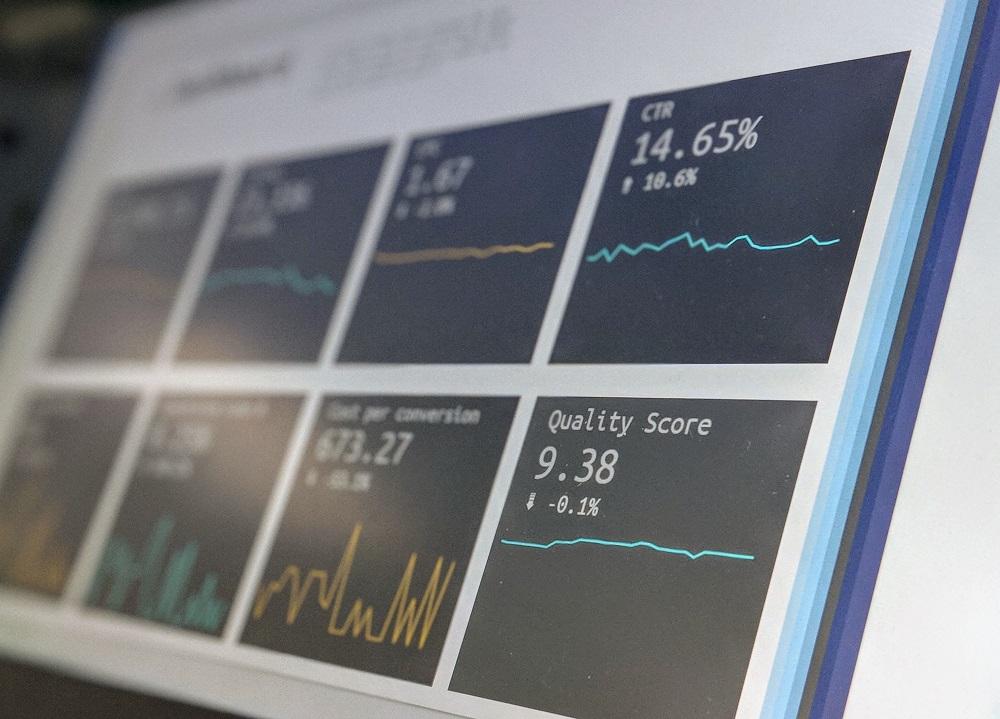
Primary Research vs. Secondary Research
Research that involves the collection of new information, or "primary" research, is distinguished from secondary research by the fact that it is conducted for the first time on a particular topic. Instead, secondary research makes use of information that has previously been gathered through primary research. The fundamental dividing line between primary and secondary research is whether the research has been done before.
5. Market Research
Market research on branding can help a business develop, launch, and sustain its brand. This may involve the firm's ethos, branding, visuals, ideals, or very name. Interviews, focus groups, and surveys are all viable options for conducting research.
6. Customer Research
Market research on customers is learning what factors most strongly affect your demographic of interest and what adjustments may be made to better attract and retain them as paying customers. The objective of this study is to acquire an intimate understanding of your consumer base and their habits and preferences as they relate to your business.
7. Competitor Research
Conducting market research on your competitors entails learning about their businesses and assessing how they stack up against your own. Your competitive product in the market or how to break into a new market could also be a topic of discussion. The study's overarching goal is to help your company prepare for the future by identifying methods to set itself apart from competitors and by learning from customers' opinions and suggestions.
8. Product Research
Conducting market research on your items is essential to ensuring they will sell successfully once they hit the shelves. Finding out how people feel about your product and if they feel it's valuable and functioning properly is the goal of this study. The ability to think creatively about enhancements and new features is another benefit.
Benefits of Market Research
According to a survey, the market research business is expected to increase at a rate of 12-14% (The Economic Times) per year through FY26, at which point it would have surpassed the $4 billion mark.

The following is a list of the most important reasons and benefits of marketing research:
It's a great tool for boosting companies' standing. The ability to think critically and act on that thinking is the key to success. You can keep your business one step ahead of the competition by conducting market research to expand your knowledge of your market or target audience.
Reduces the potential for loss on an investment. This is a basic point to think about, but it is often crucial to the success of a firm. When starting a firm, it makes sense to spend what amounts to a negligible amount on research and testing the market, product, concept, or idea.
Possible dangers and benefits are highlighted. Insurance against these two glaring pitfalls lies in both primary research (fieldwork) and secondary research (desk research). Opportunities or red flags may be uncovered through the combination of this with qualitative research for further investigation.
You can learn more about the advantages and disadvantages of your own business and of your competitors. To achieve entirely objective reporting, it is generally recommended to collaborate with a market research agency. Take advantage of what you've learned from study to improve in areas where you're weak and to gain an edge over the competition.
Strategic preparation is helped by this. Where do you stand with the core principles of your company plan? If it's supported by data, and you've put in the time and effort to do your own (hopefully continuous) research, you can rest assured that you're giving yourself the best chance of success in your commercial endeavors.
This aids in the identification of developing tendencies. Being the first, the best, or coming up with the idea that nobody else has is typically what it takes to stay ahead in business. Taking the pulse of your industry on a regular basis is an important habit. You can learn more about the tools available to you to identify and capitalize on these trends by consulting with a research firm or expert.
Helpful for firms in keeping up with the competition. Being the best calls for an insatiable need for knowledge and a propensity to experiment. The key to success, and the ability to maintain that success, is knowing how to effectively apply the information gleaned from market research, audience research, and data research.
It includes forecasts for future income. One of the most important parts of any market study is a forecast, which looks into the future and predicts the size, makeup, and trends of the market you're interested in. This allows for the categorization of prospective clients. You should prioritize the market that is the best fit for your business rather than the largest or fastest-growing.
It's geared toward meeting the wants and desires of its patrons. Many things in business, including research, benefit from keeping clients front and center. By reaching out to individuals through online panels, web forums, telephone surveys, in-depth interviews, and focus groups, market researchers can learn where their business's ideas, services, and products can be strengthened.
Using this method, one can measure the progress of one's company against predetermined standards. Utilize data gathered from the market to study the competition, gauge employee enthusiasm, identify knowledge or skill shortages, and identify development opportunities. This will allow you to consider novel approaches, ideas, and resources for boosting your company's efficiency.

Market Research Tools
In order to better understand your market and target audience, you need to use market research techniques. It's fundamental to every company's success, and in today's more crowded marketplace, a thorough familiarity with your target market is more important than ever. Good news: you don't have to be an "insights genius" to get started collecting the data you need, owing to the proliferation of market research tools. Some of the best and most widely used methods of market research include:
- Answer the Public
- Attest
- Google Trends
- Social Mention
- Remesh
- Heartbeat Ai
- Think With Google
- Spyfu
- Latana
- BuzzSumo
- Statista
- Typeform
- Otter.ai
- Dimensions.ai
How to Conduct Research for Your Business: Market Research Strategies
Despite their different objectives, market research and marketing research should use the same framework for gathering and analyzing information about your company's target audiences. These help in primary research as well as secondary research.
Clearly identify the problem at stake. Establish an initial research topic. Having a clear research question in mind will allow you to better organize your findings.
Start by figuring out your financial and time constraints. How much money do you have to put into your study? When do you anticipate finishing data collection? Research, like any other tactic for expanding your company, should be carried out within your means. Nonetheless, it may be worthwhile to spend more money to receive the most comprehensive results available, especially if the questions you are answering are time-sensitive.
Planning your approach and requirements. Find out what information needs to be gathered and figure out how to get it. Observation, surveys, phone calls, and focus groups are among the alternatives. Consult a professional research agency if you are unsure of how to organize your data collection.
Pick a way to sample the data. I need to know how you plan on picking people to take part in your study. You may require a cross-section of the consumer population at large, a subset of the population who share a particular characteristic of their way of life, or just the opinions of those who are already familiar with your brand. Develop a plan for tracking down and contacting the persons who will take part in your research.
Prepare a data analysis strategy. Think about the methods you'll use to examine the data. Do you require numbers for statistical analysis, or can you get a sense of things from qualitative, observable data? Spend some time learning about the many types of analysis so you can pick the one that will yield the most useful results for your study.
Gathering information. The next step is data collection, which may begin once you have settled on a research question and developed a strategy for answering it within the bounds of your time and money. Research is often outsourced to professional firms or consultants by many corporations.
Examining the information. It is important to apply certain methods of analysis to make sense of your data, no matter how simple it may appear at first. Which analytical techniques you employ are most suited to your data is a function of the information you've gathered. Also, this is the time to double-check for any mistakes that might have crept into your data gathering, analysis, or sampling.

Make the report you need. Concluding your research with a written report is the next to last stage. From formulating a problem statement to discussing the findings of your data study, your report should include it all.
Why is Market Research Important?
Over 44,000 businesses across the United States provide some form of market research. Their total annual income is around $23 billion (QuestionPro).
The importance of Market Research is the following -
1. Identifies new products or services
By conducting market research, a business can learn what consumers want and how to best meet their demands. Identifying the major challenges associated with creating a product or service can help you save money. It's useful for figuring out what customers value most and how to implement that into your product or service offering.
2. Identifies potential customers
You may learn more about your clientele by analyzing demographic information like their gender, age, income, occupation, and interests. You'll have a better idea of who to target with your future advertising efforts if you have a clear picture of your current clientele. When a product is marketed to the wrong demographic, sales suffer.
3. Establishes viability of a product or service
If your organization is considering introducing a novel product or service to consumers, you should find out if there is a need for it. Do people need this product? Do the people you plan to sell to actually want this product? Does it have any chance of succeeding, and does it even have a chance of being a viable trend?
4. Anticipates and discovers future market trends
If you are familiar with your market and the tendencies that are just beginning to emerge, you will be better prepared to build tactics to combat any negative tendencies that may threaten your company. As a result, you can use rising tendencies to your advantage and propel your company forward.
5. Keeps your company ahead of competitors
Examining your company's performance in relation to that of its rivals is a prime use for comparative research. If they're much ahead of you, it's a fantastic chance to figure out what you're doing wrong. It is possible to devise business plans that will help you surpass the competition.
6. Decide the best marketing strategy
Conducting research is helpful for pinpointing the optimal distribution platform for reaching your target audience. If you find out that a large portion of your audience prefers one form of communication over another, it makes sense to concentrate your efforts there. Because of the scarcity of these resources, it only makes sense to direct them toward endeavors with a high probability of success.
7. Reduces risk and increases profitability
The ability to assess the value of potential risks in light of past performance and anticipated future market behavior is a crucial business skill. The success or failure of a business idea depends heavily on the results of market research. Understanding your consumers and their habits is another crucial step in risk reduction. Taking less risk leads to greater financial rewards.
8. Identifies threats and opportunities
The SWOT analysis is likely familiar to many of you. The acronym SWOT refers to a company's "strengths," "weaknesses," and "All four of them can be figured out with the use of market research . While a lot of data can be collected through market research, not all of it needs to be used. Use only information that is directly related to your major objective (which you will have established in advance).
9. Helps to understand existing customers
By conducting market research, you can learn more about your current clientele. Because of this complexity, you can't assume that you know what your clients require. If you want to be successful, you need to take the temperature of your clientele on a frequent basis. Satisfaction levels among customers can also be measured with the help of surveys. You can find out what is bothering them and make adjustments if necessary. If they are already rather high, you can examine the factors that led to this success and implement changes to maintain it.
10. Assists in realistic goal setting
Goals that are more realistic can be established with the support of up-to-the-minute information on your market and customer base. Knowing what to expect and how to realistically expand growth over time is greatly aided by establishing a growth pattern throughout time. Setting objectives that are too lofty will cause you to waste time and energy trying to achieve something that is impossible.
.jpg)
How Efficient is Market Research?
You should only invest time, energy, and money into market research if you expect to see a favorable return on that investment. Because it is so worthwhile, market research continues to play a significant role in the success of any organization. Market research won't ensure your company's success on its own, but it will arm you with the data you need to make the moves that will.
Many of the advantages of this type of study were examined, but the drawbacks were also taken into account. If you don't conduct market research, you run the danger of losing clients to the competition, missing out on growth prospects, being more susceptible to hazards, making bad business decisions, and more. Some companies succeed without first doing their homework, but those situations are unusual. To build your firm and avoid typical errors, conduct market research.
Market Research Methods
Although there are a variety of approaches to conducting market research, the majority of companies opt to utilize one of the following five fundamental approaches: surveys, focus groups, personal interviews, observation, and field trials. Which strategies you decide to implement for your company will depend on the kinds of data you require as well as the amount of money you are ready to pay. Some of the major methods of market research are following -
1. Surveys
Surveys ask participants questions. They can use numerous survey methods. Surveys are a cost-effective technique to collect data for the study. Written surveys may encourage truthful responses since participants feel like they're speaking privately.
2. Discussions
Focus groups are moderated discussions. Companies assemble consumers to conduct focus groups, pose questions, and record replies. Participants' replies may reveal what consumers want in a firm or a product because they represent a broad group. Focus groups offer longer participant interaction than surveys.
3. Interviews
An interview combines focus group and one-on-one survey aspects. It includes recording one participant's comments at a time. Open-ended questions elicit in-depth answers from the interviewee. Researchers can ask follow-up questions and let interviewees ask their own.
4. Social media listening
Social media users routinely discuss corporations and their products. Researchers can search for discussion topics and measure consumer sentiment through social media listening.
5. Observations
Observation in market research means studying how consumers shop. Filming shoppers in a store and studying their shopping habits is common. This strategy can reveal their natural selves if they are ignorant of the observation.
6. Experiments
In a field trial, a corporation lets participants use a product under typical conditions and collects data. Participants' feedback was used to improve the product.
7. Competitive analysis
Competitive analysis is a secondary market research process where companies acquire and analyze competition information. It entails identifying primary and secondary rivals and analyzing their offerings, revenues, and marketing methods.
8. Statistics
Public data entails seeking and evaluating public market data. This research is often free online or in libraries. Research centers, polls, or government databases may provide this information. Public data is often used to confirm or compare primary market research.
9. Purchased data
Companies without the time or resources to perform their own market research can buy it. Several market research companies sell database subscriptions. Small and medium-sized businesses that can't afford primary market research may benefit from this approach.
10. Analysis of sales data
Competition analysis is just one way that may be used in tandem with sales data analysis to show how different business tactics affect revenue. It can also reveal consumers' buying behavior and consumer trends.
Functions of Marketing Research
The following are the main functions of Marketing Research -
Description: Marketing research details customers. Age, sex, education, income, etc., are listed. It describes the market and competitors. This description helps marketing decision-makers and problem-solvers.
Evaluation: Marketing research evaluates firm performance. It evaluates production and marketing policies. It measures customer reactions to product quality, price, packaging, advertising, sales, and promotions. If consumers dislike the company's policies, they must alter them. It contrasts company and rival policies.

Explanation: Marketing research answers all marketing questions. It explains why sales are declining, why retailers are unhappy, etc. It explains the problem's causes. It gives a solution.
Prediction: Marketing research forecasts. Predictions are future forecasts. It predicts sales, market prospects, dangers, marketing environment, customer behavior, etc. All predictions may be wrong. Predictions help the organization create plans and policies. It helps seize possibilities. It prevents future hazards.
Decision Making: Marketing research aids decision-makers. It gives decision-making data. Decision-making involves choosing between options. Decision-making requires accurate data. MR helps the marketer decide. It gives decision-making data. It offers alternatives. It compares each option's pros and cons. It helps marketing managers choose the right action.
Conclusion
The world's markets are changing at a dizzying rate, making it more important than ever for companies to adapt quickly enough to be competitive. One method is to conduct market research. The results of your market research and analysis will provide you with a thorough understanding of your target audience's wants and needs, as well as your competitors' strengths and weaknesses.
The key to making your business successful in the face of intense competition is identifying and fixing your deficiencies. The right market research tools will aid you in doing just that! The time to begin expanding your company is now.
With a presence in New York, San Francisco, Austin, Seattle, Toronto, London, Zurich, Pune, Bengaluru, and Hyderabad, SG Analytics, a pioneer in Research and Analytics, offers tailor-made services to enterprises worldwide.
A leader in Market research services , SG Analytics enables organizations to achieve actionable insights into products, technology, customers, competition, and the marketplace to make insight-driven decisions. Contact us today if you are an enterprise looking to make critical data-driven decisions to prompt accelerated growth and breakthrough performance.
Our Services
Investment Insights
Market Research
Data Analytics
ESG Services
Data Solutions
ESG Data Services
Technology Services
Investment Banking
Private Equity/VC
ESG Data and Research
Marketing Analytics
Advanced Analytics
Customer Analytics
Hedge Fund Services
Market Intelligence
Equity Research
Recent Blogs

Data-Driven Decision-Making: The Key to Thriving in the Digital Age

Navigating the Roadblocks: The Path Ahead for Robotaxis

Rent Rolls to Red Flags: Regional Banks Face Growing Risks with Multifamily Loans

Unlocking the Power of Unstructured Data with AI

How Long Does It Take for Rate Cuts by The Fed to Percolate to The Economy?

Future Trends and Technological Advances in Vaccine Treatment and Disease Prevention

Emergence of Novel Immune - Mediated Therapies

2024 Trends to Watch -TV & Video Technology

US OTT (SVOD) - The New Frontier

SGA Knowledge Team
We are a dynamic team of subject matter experts who create informative, relevant and...
BRAND NEW Two-Day LIVE Summit with 20+ Ecommerce Trailblazers.
- Skip to primary navigation
- Skip to main content
A magazine for young entrepreneurs
The best advice in entrepreneurship
Subscribe for exclusive access, the complete guide to market research: what it is, why you need it, and how to do it.

Written by Mary Kate Miller | June 1, 2021
Comments -->

Get real-time frameworks, tools, and inspiration to start and build your business. Subscribe here
Market research is a cornerstone of all successful, strategic businesses. It can also be daunting for entrepreneurs looking to launch a startup or start a side hustle . What is market research, anyway? And how do you…do it?
We’ll walk you through absolutely everything you need to know about the market research process so that by the end of this guide, you’ll be an expert in market research too. And what’s more important: you’ll have actionable steps you can take to start collecting your own market research.
What Is Market Research?
Market research is the organized process of gathering information about your target customers and market. Market research can help you better understand customer behavior and competitor strengths and weaknesses, as well as provide insight for the best strategies in launching new businesses and products. There are different ways to approach market research, including primary and secondary research and qualitative and quantitative research. The strongest approaches will include a combination of all four.
“Virtually every business can benefit from conducting some market research,” says Niles Koenigsberg of Real FiG Advertising + Marketing . “Market research can help you piece together your [business’s] strengths and weaknesses, along with your prospective opportunities, so that you can understand where your unique differentiators may lie.” Well-honed market research will help your brand stand out from the competition and help you see what you need to do to lead the market. It can also do so much more.
The Purposes of Market Research
Why do market research? It can help you…
- Pinpoint your target market, create buyer personas, and develop a more holistic understanding of your customer base and market.
- Understand current market conditions to evaluate risks and anticipate how your product or service will perform.
- Validate a concept prior to launch.
- Identify gaps in the market that your competitors have created or overlooked.
- Solve problems that have been left unresolved by the existing product/brand offerings.
- Identify opportunities and solutions for new products or services.
- Develop killer marketing strategies .
What Are the Benefits of Market Research?
Strong market research can help your business in many ways. It can…
- Strengthen your market position.
- Help you identify your strengths and weaknesses.
- Help you identify your competitors’ strengths and weaknesses.
- Minimize risk.
- Center your customers’ experience from the get-go.
- Help you create a dynamic strategy based on market conditions and customer needs/demands.
What Are the Basic Methods of Market Research?
The basic methods of market research include surveys, personal interviews, customer observation, and the review of secondary research. In addition to these basic methods, a forward-thinking market research approach incorporates data from the digital landscape like social media analysis, SEO research, gathering feedback via forums, and more. Throughout this guide, we will cover each of the methods commonly used in market research to give you a comprehensive overview.
Primary vs. Secondary Market Research
Primary and secondary are the two main types of market research you can do. The latter relies on research conducted by others. Primary research, on the other hand, refers to the fact-finding efforts you conduct on your own.
This approach is limited, however. It’s likely that the research objectives of these secondary data points differ from your own, and it can be difficult to confirm the veracity of their findings.
Primary Market Research
Primary research is more labor intensive, but it generally yields data that is exponentially more actionable. It can be conducted through interviews, surveys, online research, and your own data collection. Every new business should engage in primary market research prior to launch. It will help you validate that your idea has traction, and it will give you the information you need to help minimize financial risk.
You can hire an agency to conduct this research on your behalf. This brings the benefit of expertise, as you’ll likely work with a market research analyst. The downside is that hiring an agency can be expensive—too expensive for many burgeoning entrepreneurs. That brings us to the second approach. You can also do the market research yourself, which substantially reduces the financial burden of starting a new business .
Secondary Market Research
Secondary research includes resources like government databases and industry-specific data and publications. It can be beneficial to start your market research with secondary sources because it’s widely available and often free-to-access. This information will help you gain a broad overview of the market conditions for your new business.
Identify Your Goals and Your Audience
Before you begin conducting interviews or sending out surveys, you need to set your market research goals. At the end of your market research process, you want to have a clear idea of who your target market is—including demographic information like age, gender, and where they live—but you also want to start with a rough idea of who your audience might be and what you’re trying to achieve with market research.
You can pinpoint your objectives by asking yourself a series of guiding questions:
- What are you hoping to discover through your research?
- Who are you hoping to serve better because of your findings?
- What do you think your market is?
- Who are your competitors?
- Are you testing the reception of a new product category or do you want to see if your product or service solves the problem left by a current gap in the market?
- Are you just…testing the waters to get a sense of how people would react to a new brand?
Once you’ve narrowed down the “what” of your market research goals, you’re ready to move onto how you can best achieve them. Think of it like algebra. Many math problems start with “solve for x.” Once you know what you’re looking for, you can get to work trying to find it. It’s a heck of a lot easier to solve a problem when you know you’re looking for “x” than if you were to say “I’m gonna throw some numbers out there and see if I find a variable.”

How to Do Market Research
This guide outlines every component of a comprehensive market research effort. Take into consideration the goals you have established for your market research, as they will influence which of these elements you’ll want to include in your market research strategy.
Secondary Data
Secondary data allows you to utilize pre-existing data to garner a sense of market conditions and opportunities. You can rely on published market studies, white papers, and public competitive information to start your market research journey.
Secondary data, while useful, is limited and cannot substitute your own primary data. It’s best used for quantitative data that can provide background to your more specific inquiries.
Find Your Customers Online
Once you’ve identified your target market, you can use online gathering spaces and forums to gain insights and give yourself a competitive advantage. Rebecca McCusker of The Creative Content Shop recommends internet recon as a vital tool for gaining a sense of customer needs and sentiment. “Read their posts and comments on forums, YouTube video comments, Facebook group [comments], and even Amazon/Goodreads book comments to get in their heads and see what people are saying.”
If you’re interested in engaging with your target demographic online, there are some general rules you should follow. First, secure the consent of any group moderators to ensure that you are acting within the group guidelines. Failure to do so could result in your eviction from the group.
Not all comments have the same research value. “Focus on the comments and posts with the most comments and highest engagement,” says McCusker. These high-engagement posts can give you a sense of what is already connecting and gaining traction within the group.
Social media can also be a great avenue for finding interview subjects. “LinkedIn is very useful if your [target customer] has a very specific job or works in a very specific industry or sector. It’s amazing the amount of people that will be willing to help,” explains Miguel González, a marketing executive at Dealers League . “My advice here is BE BRAVE, go to LinkedIn, or even to people you know and ask them, do quick interviews and ask real people that belong to that market and segment and get your buyer persona information first hand.”
Market research interviews can provide direct feedback on your brand, product, or service and give you a better understanding of consumer pain points and interests.
When organizing your market research interviews, you want to pay special attention to the sample group you’re selecting, as it will directly impact the information you receive. According to Tanya Zhang, the co-founder of Nimble Made , you want to first determine whether you want to choose a representative sample—for example, interviewing people who match each of the buyer persona/customer profiles you’ve developed—or a random sample.
“A sampling of your usual persona styles, for example, can validate details that you’ve already established about your product, while a random sampling may [help you] discover a new way people may use your product,” Zhang says.
Market Surveys
Market surveys solicit customer inclinations regarding your potential product or service through a series of open-ended questions. This direct outreach to your target audience can provide information on your customers’ preferences, attitudes, buying potential, and more.
Every expert we asked voiced unanimous support for market surveys as a powerful tool for market research. With the advent of various survey tools with accessible pricing—or free use—it’s never been easier to assemble, disseminate, and gather market surveys. While it should also be noted that surveys shouldn’t replace customer interviews , they can be used to supplement customer interviews to give you feedback from a broader audience.
Who to Include in Market Surveys
- Current customers
- Past customers
- Your existing audience (such as social media/newsletter audiences)
Example Questions to Include in Market Surveys
While the exact questions will vary for each business, here are some common, helpful questions that you may want to consider for your market survey. Demographic Questions: the questions that help you understand, demographically, who your target customers are:
- “What is your age?”
- “Where do you live?”
- “What is your gender identity?”
- “What is your household income?”
- “What is your household size?”
- “What do you do for a living?”
- “What is your highest level of education?”
Product-Based Questions: Whether you’re seeking feedback for an existing brand or an entirely new one, these questions will help you get a sense of how people feel about your business, product, or service:
- “How well does/would our product/service meet your needs?”
- “How does our product/service compare to similar products/services that you use?”
- “How long have you been a customer?” or “What is the likelihood that you would be a customer of our brand?
Personal/Informative Questions: the deeper questions that help you understand how your audience thinks and what they care about.
- “What are your biggest challenges?”
- “What’s most important to you?”
- “What do you do for fun (hobbies, interests, activities)?”
- “Where do you seek new information when researching a new product?”
- “How do you like to make purchases?”
- “What is your preferred method for interacting with a brand?”
Survey Tools
Online survey tools make it easy to distribute surveys and collect responses. The best part is that there are many free tools available. If you’re making your own online survey, you may want to consider SurveyMonkey, Typeform, Google Forms, or Zoho Survey.
Competitive Analysis
A competitive analysis is a breakdown of how your business stacks up against the competition. There are many different ways to conduct this analysis. One of the most popular methods is a SWOT analysis, which stands for “strengths, weaknesses, opportunities, and threats.” This type of analysis is helpful because it gives you a more robust understanding of why a customer might choose a competitor over your business. Seeing how you stack up against the competition can give you the direction you need to carve out your place as a market leader.
Social Media Analysis
Social media has fundamentally changed the market research landscape, making it easier than ever to engage with a wide swath of consumers. Follow your current or potential competitors on social media to see what they’re posting and how their audience is engaging with it. Social media can also give you a lower cost opportunity for testing different messaging and brand positioning.
SEO Analysis and Opportunities
SEO analysis can help you identify the digital competition for getting the word out about your brand, product, or service. You won’t want to overlook this valuable information. Search listening tools offer a novel approach to understanding the market and generating the content strategy that will drive business. Tools like Google Trends and Awario can streamline this process.
Ready to Kick Your Business Into High Gear?
Now that you’ve completed the guide to market research you know you’re ready to put on your researcher hat to give your business the best start. Still not sure how actually… launch the thing? Our free mini-course can run you through the essentials for starting your side hustle .

About Mary Kate Miller
Mary Kate Miller writes about small business, real estate, and finance. In addition to writing for Foundr, her work has been published by The Washington Post, Teen Vogue, Bustle, and more. She lives in Chicago.
Related Posts

Create Viral Infographics That Boost Your Organic Traffic

How to Create a Video Sales Letter (Tips and Tricks from a 7-Figure Copywriter)

How to Write a Sales Email That Converts in 2024

What Is a Media Kit: How to Make One in 2024 (With Examples)

Namestorming: How to Choose a Brand Name in 20 Minutes or Less

10 Ways to Increase Brand Awareness without Increasing Your Budget

What Is a Content Creator? A Deep Dive Into This Evolving Industry

Content Creator vs Influencer: What’s the Difference?

How Much Do YouTube Ads Cost? A Beginner’s Pricing Breakdown

How to Get Podcast Sponsors Before Airing an Episode

How Founders Can Overcome Their Sales Fears with AJ Cassata

How to Grow Your YouTube Channel & Gain Subscribers Quickly

How to Write Good Instagram Captions That Hook Your Audience

Discovering the Best CRM for Consultants

10 Instagram Growth Hacks For More Engaged Followers (Without Running Ads)
FREE TRAINING FROM LEGIT FOUNDERS
Actionable Strategies for Starting & Growing Any Business.
Discover WMC Products
Accelerate your business growth with tailored intelligence solutions

Competitor Intelligence Service
Empowering You To Outmaneuver Rivals And Dominate Your Market

Client Intelligence Service
Unlock the Full Potential of Your Client Relationships

Regulatory Intelligence Service
Navigate the Regulatory Landscape with Confidence

Government Intelligence Service
Master the Global Political Landscape
How it Works?
Track competitors and power your organisation's growth
Identify commercial threats and opportunities
WMC ROI Calculator
Integrations.
Explore integrations
Chrome Extension
Discover our mobile app
Automated Tracking
Task tracker, analyst insights, analytics & trends, battlecards, new feature.
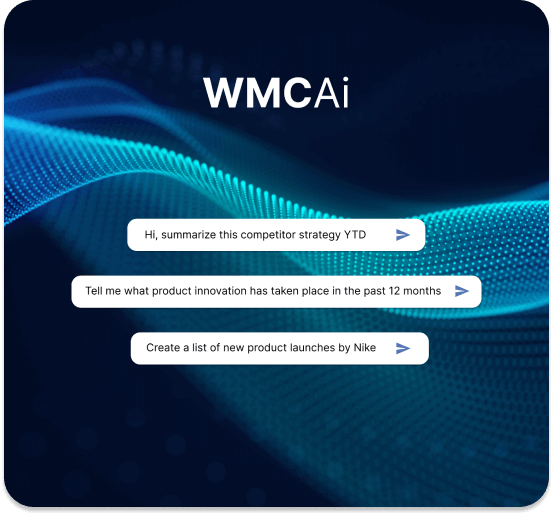
AI-driven insights tailored for diverse industries
Provide targeted recommendations to your teams
- Manufacturing
- Financial Services
- Telcos & Internet
- Professional Services
Your success is our priority
We're here to empower you every step of the way

Using Competitive Intelligence In Your Sales Enablement Strategy
Equip your sales teams with a powerful tool to understand the market.
Customer Success Identify wider-industry trends Digital Transformation Identify wider-industry trends Insights Free your team from outdated data collection methods Marketing Maximise business success with marketing intelligence Product Latest company updates and industry knowledge Sales Latest company updates and industry knowledge Strategy Latest company updates and industry knowledge Outsmart the competition with WMC
Protect and grow you revenue

Why Market Research Is Important: A Complete Guide
Did you know that 66% of customers expect companies to understand their needs, while customer-centric companies are 60% more profitable than companies that aren’t. Meanwhile, over half (53%) of business executives are concerned about competition from disruptive businesses.
If you aren’t on top of your market and meeting your ideal customers’ needs, you risk being left behind. Outmanoeuvred by better informed, faster-moving competitors.
This is why market research is important: it gives you valuable insights that protect your market position. In this article, we take a deeper look at the value it can bring to your business in a comprehensive guide.

Defining Market Research
Market research refers to the process of gathering and analysing data about customers, competitors, and market trends to gain insights and make informed business decisions. It helps businesses understand their target audience, identify opportunities, and develop effective marketing strategies.
By undertaking market research , businesses can make data-driven decisions that drive growth, innovation and competitive advantage.
The Core Components Of Market Research
Market research comprises several essential components and methods:
A) Qualitative research
This approach focuses on exploring the underlying motivations, attitudes and perceptions of individuals or groups. It often involves techniques such as interviews, focus groups and open-ended surveys. Qualitative research helps uncover insights that quantitative data alone cannot provide, offering a richer understanding of consumer behaviour.
B) Quantitative research
In contrast to qualitative research, quantitative research relies on numerical data and statistical analysis. It involves surveys, questionnaires, experiments, and structured observations to gather data from a large sample size. Quantitative research is valuable for measuring and quantifying trends, patterns, and correlations within a market.
C) Primary research
Primary research involves collecting firsthand data specifically for the research objectives at hand. This can be done through surveys, interviews, observations or experiments tailored to the research’s unique requirements. Primary research provides fresh and specific insights but can be time-consuming and costly.

D) Secondary research
Secondary research, also known as desk research, involves the analysis of existing data and information collected by others. Researchers access databases, reports, academic papers and publicly available data to gather insights. It’s a cost-effective way to obtain a broader perspective on a market but may lack the specificity of primary research.
E) Market segmentation
Market research often involves dividing a market into distinct segments based on various criteria such as demographics, psychographics, behaviour or geographic location. Segmenting a market helps businesses target their marketing efforts more effectively and tailor their products and services to meet specific customer needs.
F) Data collection methods
Market researchers employ various data collection methods, including surveys, interviews, focus groups, observations and online analytics. The choice of method depends on the research objectives, budget and the type of data required.
G) Data analysis
Once data is collected, it must be analysed to extract meaningful insights. Statistical tools, software and expertise are often used to process and interpret data accurately.
Market research is not a one-size-fits-all activity. The choice of components and methods depends on the specific research objectives, the target audience and the resources available. It’s a dynamic and iterative process that can uncover valuable insights, guide strategic decisions and ultimately contribute to business success.
The Importance of Market Research: An Overview
In an increasingly competitive and rapidly changing business landscape, market research is important because it helps organisations of all sizes and industries. It offers critical insights, reducing uncertainty and enabling data-driven decisions.
In this section, we’ll delve into the overarching importance of market research in today’s business environment.
1) Navigating uncertainty
Businesses operate in an environment marked by uncertainty. Market conditions can shift unpredictably due to economic fluctuations, technological advancements and global events. Market research acts as a stabilising force, helping businesses navigate uncertainty by providing a solid foundation of knowledge.
2) Risk mitigation
One of the primary roles of market research is risk mitigation. Understanding the potential risks and challenges that lie ahead allows businesses to prepare effectively. By identifying market trends, consumer preferences and competitive landscapes, organisations can anticipate challenges and develop strategies to mitigate them. This proactive approach not only safeguards businesses but also positions them for resilience and growth.
3) Strategic decision-making
The strategic decisions made by a business are pivotal to its success. Market research informs these decisions by offering insights into market dynamics, customer behaviour and industry trends. Whether it’s expanding into a new market, launching a new product or fine-tuning marketing strategies, businesses can align their actions with market realities, increasing the likelihood of success.
4) Customer-centric approach
In the age of customer-centricity, understanding the needs, preferences and expectations of consumers is paramount. Market research places the customer at the heart of business operations. By collecting and analysing customer feedback, businesses can tailor their products, services and marketing efforts to resonate with their target audience. This customer-focused approach enhances customer satisfaction and loyalty.
5) Competitive advantage
In a crowded marketplace, gaining a competitive edge is a constant pursuit. Market research provides the tools to outmanoeuvre competitors by offering insights into their strategies, strengths and weaknesses. Armed with this knowledge, businesses can differentiate themselves, identify unexplored opportunities and stay ahead of the competition.
6) Financial planning & resource allocation
Efficient resource allocation is essential for a company’s financial health. Market research informs budgeting decisions by identifying areas where investments will yield the highest returns. Whether it’s allocating marketing budgets, research and development funds, or capital for expansion, businesses can optimise their resource allocation based on data-driven insights.
7) Adaptation to change
Change is the only constant in the business world. Market research equips businesses with the agility to adapt to shifting market dynamics. By staying attuned to emerging consumer trends, economic shifts, and unforeseen events, organisations can pivot their strategies effectively. This adaptability is crucial for survival and growth, particularly in fast-paced industries.
8) Measurable outcomes
A well-executed market research strategy comes with measurable outcomes. Businesses can track the impact of their decisions, assess the effectiveness of marketing campaigns, and adjust strategies in real-time based on data-driven insights. This leads to less waste, improved efficiency and better results.
9) A strategic asset
Market research is not an optional extra but a strategic asset. It is the compass, the risk mitigator and the foundation upon which successful businesses are built. It guides organisations through uncharted waters, helping them make informed choices, seize opportunities and navigate challenges.
How To Conduct Market Research
Market research is a process that involves gathering, analysing and interpreting data to gain insights into markets, consumers and competitors.
Conducting effective market research requires careful planning and the use of various research methods and techniques. In this section, we will outline the steps and strategies involved in conducting market research.
Step 1: Define your research objectives
Before diving into research, it’s essential to clearly define your objectives. What specific information are you seeking to obtain through market research? Are you interested in understanding consumer preferences, evaluating market trends or assessing the competitive landscape? Clearly defined research objectives will guide your research efforts and help you stay focused.
Step 2: Choose your research methodology
Market research can be broadly categorised into two main types: primary research and secondary research .
Primary research : Involves collecting original data directly from sources via methods such as surveys, interviews and observations, offering specific and current insights aligned with research goals.
Secondary research : Entails analysing existing data from sources like market reports and academic studies, providing cost-effective access to valuable context and background information.
Select the research methodology that aligns with your research objectives, timeline and budget. Often, a combination of primary and secondary research is used to gain a comprehensive understanding of the market.
Step 3: Design your research instruments
If you choose to conduct primary research, you’ll need to design research instruments such as surveys, questionnaires or interview guides. Ensure that your research instruments are clear, unbiased and designed to collect relevant data. Pilot testing your instruments with a small group can help identify and address any issues before full-scale data collection.
Step 4: Collect data
Data collection is a critical phase of market research. For primary research, you’ll administer surveys, conduct interviews or organise focus groups to gather data from participants.
Ensure that data collection methods are consistent, and follow ethical guidelines when handling sensitive information. For secondary research, you’ll access and review existing data sources, extracting relevant information for your analysis.
Step 5: Analyse data
Once you’ve collected data, the next step is data analysis. This involves organising, cleaning and interpreting the data to extract meaningful insights. Data analysis may include statistical techniques, content analysis or qualitative coding, depending on the nature of the data.
6) Interpret findings
After analysing the data, it’s essential to interpret the findings in the context of your research objectives. What do the data and insights reveal about the market, consumers and competitors? Consider the implications of your findings and how they relate to your business goals.
7) Make informed decisions
The ultimate goal of market research is to inform decision-making. Based on your research findings, make informed decisions about product development, marketing strategies, target audiences, pricing and other aspects of your business. Use the insights gained from market research to enhance your competitive advantage.
8) Continuous monitoring
Market research is not a one-time activity. Markets evolve, consumer preferences change and competitors adapt. Therefore, it’s important to establish a system for continuous monitoring and updating your market research efforts. Regularly gather new data, track market trends and reassess your strategies to remain competitive.
Final Thoughts
To conclude, market research is vital in today’s business landscape. M arket research is a dynamic and iterative process that empowers businesses to make informed decisions, minimise risks and stay competitive . By understanding customer preferences, industry trends, and competitive landscapes, businesses can tailor their strategies for success.
Market research is the compass that guides product development, marketing campaigns and expansion efforts, ensuring resources are invested wisely. By following these steps and adopting a research-driven mindset, organisations can unlock valuable insights and position themselves for success in today’s ever-changing business landscape.
Recent Posts
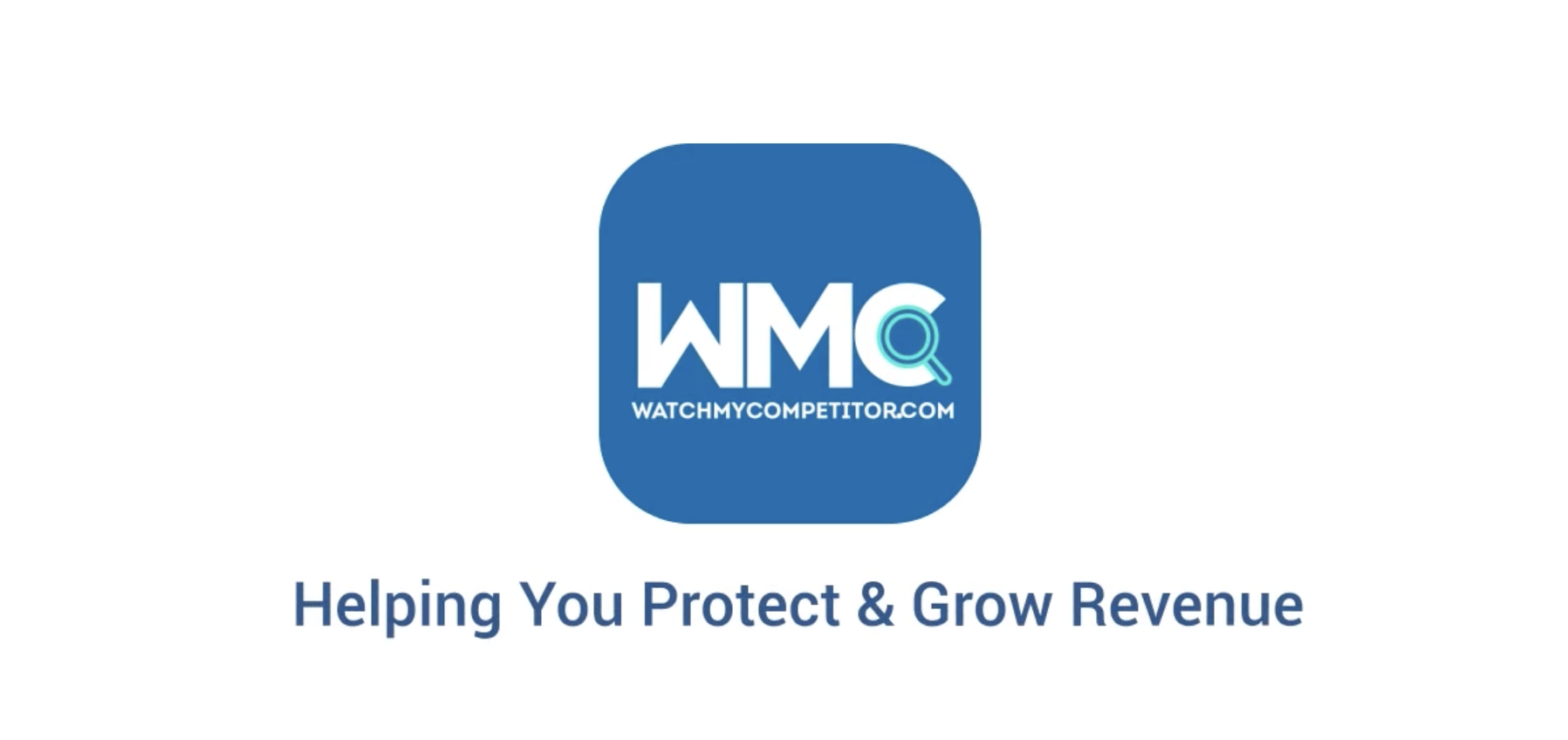
Introduction to WMC
An overview of WatchMyCompetitor and how our innovative product can help your business!

Competitive Marketing Intelligence vs Competitive Intelligence
What is competitive marketing intelligence? How does it differ from competitive intelligence? Do you need both?

Market Research Components | 2023 comprehensive Guide
Introduction What is Market Research? Market Research is the systematic […]

Published on
Introduction
What is market research.

Market Research is the systematic process of gathering, analyzing, and interpreting information about a specific market. This includes understanding the target audience, identifying market trends, assessing competitors, and more.
The information collected through market research helps businesses make well-informed decisions, reduce risks, and identify new opportunities.
For a comprehensive guide on initiating and executing successful market research, be sure to explore our detailed post on Conducting Market Research 101 .
Why is Market Research Important?
In an increasingly competitive and dynamic business environment, market research has become an essential tool for success. It provides the insights needed to:
- Understand Consumers: It helps businesses know their customers’ needs, preferences, and behaviors.
- Identify Opportunities: Market research uncovers gaps in the market that can be filled with innovative products or services.
- Mitigate Risks: By understanding the external environment, businesses can avoid potential pitfalls.
- Shape Strategies: It informs decision-making processes, ensuring that strategies are aligned with market realities.
In this comprehensive guide, we will explore the many facets of market research, leveraging decades of industry experience and knowledge. Whether you’re a business owner, a marketing professional, or simply interested in the field, this article will provide you with the expertise you need.
Here’s what we’ll cover:
- Market Size: Understanding the total volume of a given market.
- Potential Growth: Forecasting market expansion and opportunities.
- Market Trends: Analyzing current and future trends affecting the market.
- Consumer Analysis: Examining consumer behaviors and preferences.
- Competitors Analysis: Assessing your competitors’ strengths and weaknesses.
- SWOT Analysis: A strategic tool for evaluating a business’s internal and external environment.
- PESTEL Analysis: Investigating macro-environmental factors affecting the market.
- Porter’s Five Forces Analysis: Analyzing the competitive forces within your industry.
- Additional Analyses: Exploring other relevant tools and frameworks.
From understanding the market size to employing advanced analytical tools like SWOT and PESTEL, this article offers a complete guide to market research. It’s built on years of professional expertise and aims to be a reliable and authoritative source for anyone seeking to navigate the complex world of market research.
Uncover the role of SWOT analysis in decoding the restaurant industry’s intricacies in our article: SWOT Analysis for Restaurant.
Market Size
Market Size refers to the total number of potential buyers or the total volume of sales for a particular product or service within a given market. It’s a critical metric that offers valuable insights into the landscape of an industry and can significantly impact strategic business decisions.
Understanding market size allows businesses to:
- Identify Potential: Knowing the market size helps in assessing the potential demand and the feasibility of entering a new market or launching a new product.
- Allocate Resources Efficiently: With accurate market size data, companies can allocate their marketing and production resources more effectively.
- Benchmark Performance: It enables businesses to compare their sales and performance against the total market potential.
Calculating the market size can be complex, depending on the industry and the information available. Here are some common approaches used by experts:
- Top-Down Approach: This method starts with a broad view of the industry and narrows down to a specific segment or product. It often involves using existing research and industry reports.
- Bottom-Up Approach: A more granular method, this starts with the smallest part of the market and builds up. It often involves primary research, such as surveys and interviews.
- Demand and Supply Analysis: Examining both supply and demand factors within the market to understand the overall size and potential.
Market size isn’t just a number; it’s a vital part of strategic planning:
- Segmentation and Targeting: Understanding market size helps in segmenting the market and targeting specific customer groups effectively.
- Investment Decisions: Investors and stakeholders often use market size to gauge the potential returns and risks associated with a market.
- Competitive Positioning: It helps businesses understand where they stand in comparison to competitors and the overall market.
Potential Growth
Potential Growth refers to the future expansion opportunities within a given market. It’s a forecast that provides insights into the possible growth of a market segment, industry, or economy. Understanding potential growth helps businesses in strategic planning, investment decisions, and resource allocation.
Identifying potential growth requires careful analysis using various methods and tools. Here are some commonly utilized techniques:
- Market Segmentation Analysis: Breaking down the market into smaller segments to identify underserved or emerging areas.
- Trend Analysis: Studying current market trends and extrapolating them to predict future growth paths.
- Competitive Landscape Analysis: Evaluating competitors’ strategies and performance to uncover opportunities for differentiation and growth.
- Economic Forecasting: Using economic indicators and models to predict the overall growth potential of a market.
Potential growth isn’t just a projection; it’s a critical component of business strategy:
- Product Development: Guides the innovation and development of new products to meet future market demands.
- Investment Planning: Assists in making investment decisions based on expected returns and growth prospects.
- Marketing Strategy: Helps in shaping marketing campaigns and channels to reach emerging market segments.
- Risk Management: Aids in understanding potential risks and uncertainties associated with market expansion.
Market Trends
Market Trends refer to the general direction or movement of a market or industry over time. These trends can be upward, downward, or even sideways and are typically influenced by various factors such as economic conditions, consumer behaviors, technological advancements, and more.
Understanding market trends is pivotal for businesses for several reasons:
- Strategic Alignment: Aligning products, services, and marketing strategies with current trends enhances relevance and competitiveness.
- Opportunity Identification: Recognizing emerging trends can lead to the discovery of new business opportunities or potential threats.
- Consumer Engagement: By resonating with current trends, businesses can create a stronger connection with their target audience.
Examples of Market Trends:
- E-commerce Growth: The ongoing shift towards online shopping, especially amplified by the COVID-19 pandemic.
- Sustainability Focus: Increasing consumer interest in environmentally friendly products and sustainable business practices.
- Personalization in Marketing: The use of data analytics to provide personalized experiences and offerings to consumers.
Utilizing Market Trends for Competitive Advantage
Successfully leveraging market trends can give businesses a significant competitive edge:
- Product Innovation: Developing new products that align with emerging trends.
- Marketing Adaptation: Adapting marketing messages and channels to resonate with current market sentiments.
- Strategic Partnerships: Collaborating with other businesses or influencers that align with trending topics or values.
- Investment Decisions: Allocating investments into areas that are trending upward, providing better returns.
Market trends are a vital aspect of market research, offering insights that can shape business strategies and drive success in today’s fast-paced and ever-changing business environment.
Consumer Analysis

Consumer Analysis involves studying the behavior, needs, preferences, and buying patterns of consumers. It’s a crucial part of market research, allowing businesses to tailor their products, services, and marketing strategies to meet the specific needs of their target audience.
Consumer behavior encompasses the decisions and actions that consumers undertake when selecting, purchasing, using, and disposing of products or services. Here’s how businesses explore this aspect:
- Psychographics: Studying attitudes, interests, lifestyles, and values of consumers.
- Demographics: Analyzing age, gender, income, and other statistical aspects.
- Behavioral Patterns: Observing purchase history, brand loyalty, and interaction with products.
Tools and Techniques for Consumer Analysis
- Surveys and Interviews: Direct interaction with consumers to gain insights into their preferences and opinions.
- Observational Research: Studying consumers in a natural setting to understand their behavior.
- Data Analytics: Leveraging big data and analytics tools to process large amounts of consumer information.
- Social Media Monitoring: Analyzing social media activity to gauge consumer sentiments and trends.
Implementing Insights into Marketing Strategies
Consumer Analysis isn’t just about gathering data; it’s about translating those insights into actionable strategies:
- Product Development: Tailoring products to meet the specific wants and needs of the target audience.
- Personalized Marketing: Using consumer insights to create personalized marketing messages and offers.
- Distribution Decisions: Choosing the right channels and locations based on where the target consumers are most active.
- Customer Service Enhancement: Improving customer service by understanding and anticipating consumer needs.
Consumer Analysis is the heartbeat of market research, putting the consumer at the center of business decisions. By understanding who the consumers are, what they want, and how they behave, businesses can create more compelling offerings and build stronger connections with their audience.
Competitor Analysis

Competitor Analysis involves evaluating the strengths and weaknesses of current and potential competitors. This essential aspect of market analysis provides insights into the competitive landscape, allowing businesses to identify opportunities, threats, and strategies to gain a competitive edge.
Understanding the types of market research required for Competitor Analysis involves recognizing the different levels of competitors:
- Direct Competitors: Businesses that offer similar products or services.
- Indirect Competitors: Those who provide alternatives that could replace your product or service.
- New Entrants: Companies that are newly entering the market and could become competitors.
In conducting the research to analyze competitors, businesses often employ both secondary and primary research methods:
- Primary Market Research: Involves collecting firsthand information directly from the market through surveys, interviews, and direct observations. This approach offers specific insights into competitors’ customer satisfaction levels, brand perception, and more.
- Secondary Market Research: Utilizes existing data and research studies, like competitors’ annual reports, websites, and industry publications. This method is more cost-effective and helps in understanding competitors’ market positioning, financial health, and product offerings.
Importance of Analyzing Competitors
- Strategic Planning: Understanding competitors’ strategies helps in shaping your own business plans and tactics.
- Benchmarking: Comparing your business performance against competitors to identify areas for improvement.
- Risk Mitigation: Identifying potential threats from competitors and developing strategies to counter them.
Research companies often employ Competitor Analysis to provide tailored solutions to their clients. For example, they might analyze competitors’ social media strategies to help a client improve its online presence or evaluate pricing strategies to support a client in positioning its products more competitively.
Competitor Analysis is an indispensable part of what market research is. It equips businesses with the intelligence they need to navigate the competitive landscape effectively. By employing both primary and secondary research methods and leveraging research tools, companies can build robust strategies that resonate with their market positioning and goals.
Looking to delve deeper into understanding your competition? Discover our 6-Step Competitor Analysis Guide that provides actionable insights for staying ahead in your industry.
SWOT Analysis
SWOT Analysis is a strategic tool used to identify and analyze the Strengths, Weaknesses, Opportunities, and Threats related to business competition or project planning. It’s a crucial part of the market research analysis process, offering a comprehensive view of the internal and external factors that can impact a business.
Components of SWOT Analysis:
- Strengths: Internal attributes that give an advantage over competitors.
- Weaknesses: Internal limitations that might hinder success.
- Opportunities: External factors that the organization could potentially leverage.
- Threats: External challenges that could negatively affect the business.
Importance of SWOT Analysis
- Strategic Planning: SWOT helps in setting objectives and developing strategies to achieve them.
- Decision Making: It aids in making informed business decisions by understanding the internal capabilities and external market dynamics.
When conducting a market research using SWOT, it’s vital to follow these steps:
- Identify Objectives: Define clear goals for the analysis.
- Gather Information: Utilize both primary and secondary research to collect relevant data.
- Analyze Strengths and Weaknesses: Assess internal factors by evaluating resources, processes, and capabilities.
- Identify Opportunities and Threats: Examine external market conditions, regulations, and trends.
- Create Strategies: Develop actionable plans based on the insights gathered.
SWOT Analysis is an invaluable component of market research that provides a holistic view of an organization’s position within the marketplace. It guides strategy, informs decision-making, and fosters a deeper understanding of the challenges and opportunities that lie ahead.
You can also read our 10-Steps for Writing a Powerful SWOT Analysis article.
As we continue to explore the different facets of market research, we’ll delve into other analysis techniques like PESTEL Analysis and Porter’s Five Forces Analysis, which further expand our understanding of the market environment.
PESTEL Analysis
PESTEL Analysis is a strategic tool used to identify and evaluate the macro-environmental factors that might affect an organization. It examines the Political, Economic, Social, Technological, Environmental, and Legal aspects that can influence the market landscape.
PESTEL Analysis helps in understanding the external environment in which a business operates. Here’s why it’s essential:
- Strategic Alignment: It allows businesses to align their strategies with the external factors that might affect them.
- Risk Identification: Identifies potential risks and uncertainties in the market, enabling proactive planning.
- Opportunity Discovery: Unveils potential opportunities that can be leveraged for growth.
Components of PESTEL Analysis
- Political Factors: Government policies, regulations, political stability, etc.
- Economic Factors: Economic growth, inflation rates, exchange rates, etc.
- Social Factors: Cultural aspects, demographics, lifestyle trends, etc.
- Technological Factors: Technological advancements, automation, innovation, etc.
- Environmental Factors: Environmental regulations, climate change, sustainability concerns, etc.
- Legal Factors: Legal frameworks, labor laws, intellectual property rights, etc.
Understanding the broader market trends requires a systematic approach to PESTEL Analysis:
- Identify the Scope: Define the industry, region, and time frame for the analysis.
- Collect Data: Utilize secondary research methods, like industry reports, government publications, and academic research.
- Analyze Factors: Evaluate each PESTEL factor and its potential impact on the business.
- Develop Strategies: Craft strategies that capitalize on opportunities and mitigate threats.
Market research companies often incorporate PESTEL Analysis to offer a comprehensive view of the market conditions. This analysis helps in identifying opportunities, understanding risks, and crafting strategies that resonate with the current market environment.
PESTEL Analysis is an indispensable part of market research, providing insights into the macro-environmental factors that shape the market landscape. It complements other analyses like SWOT and Competitor Analysis by adding a broader perspective that informs strategic planning and decision-making.
In our next section, we’ll explore Porter’s Five Forces Analysis, further delving into the analytical frameworks that support market research.
Porter’s Five Forces Analysis
Porter’s Five Forces Analysis is a framework that helps businesses understand the competitive forces that shape an industry and impact profitability. Developed by Michael E. Porter, this analysis focuses on five key forces that determine the intensity of competition and attractiveness of an industry.
- Competitive Rivalry (Industry Competition): Analyzes the intensity of competition among existing players in the industry. A high level of rivalry may lead to price wars and reduced profitability.
- Bargaining Power of Suppliers: Evaluates the ability of suppliers to influence prices and terms. If suppliers have significant power, they may demand higher prices, impacting business costs.
- Bargaining Power of Buyers: Assesses the influence of buyers (customers) on prices and product features. If buyers have substantial bargaining power, they can pressure businesses to reduce prices or enhance quality.
- Threat of New Entrants: Examines the ease with which new competitors can enter the market. Barriers to entry, like capital requirements and regulations, affect this threat level.
- The threat of Substitute Products or Services: Analyzes the risk posed by alternative products or services that can replace the existing offerings. A high threat of substitutes can reduce demand and profitability.
Conducting a Porter’s Five Forces Analysis requires a systematic approach:
- Define the Industry: Identify the specific industry or market segment under examination.
- Analyze Each Force: Evaluate the five forces to understand their influence on the industry.
- Identify Key Players: Recognize the main competitors, suppliers, buyers, and potential entrants.
- Assess Barriers and Opportunities: Determine barriers to entry, potential threats, and opportunities for growth.
- Develop Strategies: Formulate strategies that leverage strengths, counter threats, and capitalize on opportunities.
Research companies use Porter’s Five Forces Analysis to provide in-depth insights into an industry’s competitive landscape. It aids in strategic planning, investment decisions, market entry strategies, and more.
Porter’s Five Forces Analysis is a vital component of any market research process, offering a nuanced understanding of the competitive forces that shape an industry. By comprehensively evaluating these forces, businesses can craft robust strategies that align with the market dynamics and foster growth and sustainability.
Market research is a comprehensive and multifaceted discipline that sits at the heart of successful business strategy.
The process of conducting a market research involves both primary and secondary approaches, employing various market research tools to collect, analyze, and interpret data. It helps organizations understand market size, growth potential, emerging trends, competition, and consumer preferences.
Research companies leverage these analyses and tools to offer actionable insights that guide decision-making, strategy formulation, product development, and marketing efforts. Understanding what is market research and how to effectively conduct it is essential for businesses seeking to navigate the complex and ever-changing market environment.
With the right approach to market research, organizations can uncover opportunities, mitigate risks, and craft strategies that resonate with their target audience. It’s not just about gathering information; it’s about translating that information into meaningful actions that drive growth and success.
Whether you’re an established corporation or a burgeoning startup, market research is an indispensable asset that fosters innovation, competitiveness, and sustainability. By embracing the myriad analyses and methodologies encompassed within market research, you set the stage for informed decision-making and strategic excellence.
If you find yourself in need of professional assistance in conducting market research, look no further than our expert team at Globemonitor. With a wealth of experience and specialized tools at our disposal, we provide tailored market research solutions that drive actionable insights and business growth.
Whether you’re looking to understand your target audience, analyze competitors, or explore new market opportunities, we’re here to help you every step of the way. Don’t hesitate to contact us today, and let’s embark on a successful market research journey together.
Frequently Asked Questions (FAQs)
1. What is market research, and why is it important?
Market research is the process of collecting, analyzing, and interpreting data about the market, including customers, competitors, trends, and other factors. It is vital for understanding market needs, identifying opportunities, minimizing risks, and making informed business decisions.
2. What are the 7 steps in marketing research?
The seven steps in marketing research are:
- Defining the research problem
- Determining the research design
- Choosing the research method (primary or secondary)
- Collecting data
- Analyzing data
- Interpreting findings
- Reporting and presenting results
3. How is market research done?
Market research is conducted through various methods such as surveys, interviews, observations, and experiments. It includes both primary research, involving direct data collection from target audiences, and secondary research, utilizing existing data sources.
4. What is a good example of market research?
A good example of market research might be a company conducting surveys and focus groups to understand customer preferences for a new product line. The insights gained from this research can guide product development, pricing, and marketing strategies.
5. Who uses market research?
Market research is used by businesses of all sizes, government agencies, non-profit organizations, and educational institutions. It helps in understanding market dynamics, customer needs, competition, and other critical factors to make informed decisions.
6. How do you define market size?
Market size is defined as the total number of potential customers or sales volume within a specific market segment or industry. It can be measured in terms of revenue, units sold, or population, depending on the context.
7. How do you identify market segments?
Market segments are identified by dividing the market into distinct groups based on shared characteristics such as demographics, psychographics, behavior, and needs. Segmentation helps in tailoring marketing strategies to specific target audiences.
8. How to design a marketing strategy?
Designing a marketing strategy involves understanding the target audience, analyzing the competition, defining marketing goals, choosing marketing channels, developing unique selling propositions, and implementing, monitoring, and adjusting the strategy as needed.
9. What are some credible governmental sources that can be utilized for data in market research process?
- For national economic statistics and insights, the U.S. Bureau of Economic Analysis provides valuable information that can be instrumental in market research.
- Analyzing labor market trends is made easier with data from the U.S. Bureau of Labor Statistics , a credible governmental source for employment statistics and forecasts.
- For businesses looking to explore international markets, the World Bank’s Open Data is an essential resource that offers free and open access to global development data.
- The U.S. Census Bureau provides detailed demographic and population data, essential for segmenting and understanding target audiences in market research.
- To assess industry regulations and legal considerations, the U.S. Federal Trade Commission offers comprehensive resources and guidelines that can influence market entry and compliance strategies.
- For healthcare market researchers, the Centers for Disease Control and Prevention (CDC) provides crucial data on public health trends and policies, influencing product development and marketing strategies.
- Environmental considerations in market research can be informed by data from the U.S. Environmental Protection Agency (EPA) , especially for businesses focusing on sustainability and ecological impact.
10. How to do market research for a startup?
Conducting market research for a startup means setting clear research objectives, pinpointing the target audience, gathering data via diverse methods such as surveys, interviews, and competitor analysis, and then analyzing this information to derive actionable insights.
For a detailed guide on this process, check out our comprehensive post on how to do market research for a startup in 2023
About the Author: Loaloa Riad
Subscribe to our newsletter
Get valuable insights and business guidance sent to your email.
Related Posts

What is One of the Best Ways to Get Reliable Information About a Product? | Expert Insights

Market Analysis for Restaurant: A 2024 Comprehensive Guide

Business Adjectives: Mastering Business Communication in 2024
© 2024 Copyright • GlobeMonitor.co • All Rights Reserved

Don’t miss out on valuable insights
Stay up-to-date with the latest market trends and insights! Subscribe to our newsletter now and receive exclusive content and updates directly to your inbox.
- Product management
- Product research
- How to do market research
How product managers should do market research
Why do customers buy your product? The simple answer is they have a problem to solve. But a deeper explanation exists beyond the benefits and features of what you offer. You must understand who your customers are, what they really care about, and why they choose your product over another if you want to ensure long-term success.
This is something product managers know well. In fact, it is part of the job. Product managers are responsible for determining what target customers need and value to build a product they will love. This process is called product discovery . And it begins with research.
Market research involves gathering and analyzing information about the overall market environment, prospective customers, and competitors for your product or service. For product managers, this helps you formulate a nuanced worldview of the opportunities and threats that exist for your offering. Think of it like studying a habitat — you are exploring the elements that could affect your product's ability to thrive. Like any habitat, conditions can be variable. You will want to keep learning and observing as markets are constantly shifting (especially in the tech industry).
While research is a core product management task, the entire cross-functional product team needs to understand the market — each representative will zero in on different aspects to help your product succeed. This guide will give you an overview of what market research entails and how to get started conducting your own.
Vision, market research, user feedback — manage it all in Aha! Roadmaps. Try it free .
Why is market research important.
Understanding the market is an important part of crafting your product strategy — along with defining what you want to achieve and how you plan to get there . Market research brings external factors into consideration.
This is important because market research is critical to finding product-market fit . You need to deeply understand your market position, audience, and any alternative solutions if you want your product to succeed. This matters whether you are launching a new product, enhancing an existing offering, or entering a new market.
In other words — intuition alone is not enough. Even if you have a clear product vision and substantial industry experience, conducting regular market research often uncovers new and unexpected ways to improve your product. This can also improve your resilience as an organization.
Of course, there will always be external forces you cannot control. But if you have a deep understanding of the market environment and customer values, you will be in a better position to adapt to challenging situations.
Plus, market research enables all members of the core product team to make more informed decisions. The following are only a few examples of many, but market research helps:
Product management — Empathize with customers and understand their needs to better prioritize upcoming product work.
UX design — Make design choices that reflect how customers want to use modern products.
Engineering — Stay up-to-date with technologies used by competitors.
Product marketing — Update product positioning to resonate with what customers want to hear.
Related: How do product managers work with other teams?
What are the components of market research?
For product development purposes, you will want to explore three core components of market research — the overall market landscape, competitive analysis, and customer research.

Overall market landscape
Examining the market as a whole is a good place to start. Typically this piece of market research looks at macro-level industry characteristics and customer behavior. Below is a list of different factors to consider when researching the market landscape.
A PESTLE analysis — which stands for political, economic, social, technological, legal, and environmental — can be a helpful exercise to get your team thinking about the broader market and where your product will fit into it. Give it a try in Aha! software with this whiteboard template:
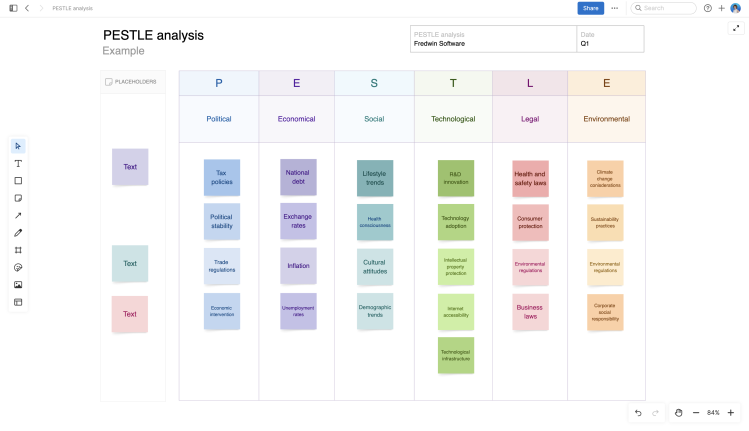
Start using this template now
Competitive analysis
Researching competitors involves looking at established players in the market and alternative solutions used by prospective customers. By assessing competitor strengths and weaknesses, you can learn how to differentiate your product.
Read more: A guide to competitive analysis
Customer research
Customer research drives product innovation by enabling you to glean insights directly from your target audience. This helps product teams build empathy for the problems customers want to solve. It can also reveal your customers' true feelings about your product.
Read more: A guide to customer research
How to do market research as a product manager
The market research process will vary in complexity depending on the scale and extent of your plans. Launching a brand new offering often calls for a comprehensive analysis of the entire market — in other scenarios, like enhancing established products, a lightweight look at the current competition could suffice. But in general there are four essential steps for conducting successful market research:
Define your objectives. In order to collect the right data, you must first establish what you are trying to learn. Clarify the focus of your market research by listing out the questions you have about a problem or opportunity, then distill this into a goal statement.
Plan and conduct research. Figuring out where to find the information you need. You can employ a mix of primary and secondary sources — primary includes interviews, surveys, and focus groups while secondary includes sources like industry publications, trade associations, and market reports.
Analyze and share the results. Once you have gathered your data, review it closely to uncover trends and other insights. Summarize your findings and make them accessible to your team. You might even create a presentation to showcase what you discovered.
Plan next steps. Market research should inform action. Use your newfound learnings to build customer personas , form a well-rounded product strategy, or prioritize product decisions that will deliver more value to the market.
Many product managers expedite their research and analysis by using pre-built templates. If you want to get started fast, download one of our customizable research templates or the SWOT analysis whiteboard template . This framework is helpful both for identifying what to research and organizing your findings for discussion after research is complete.
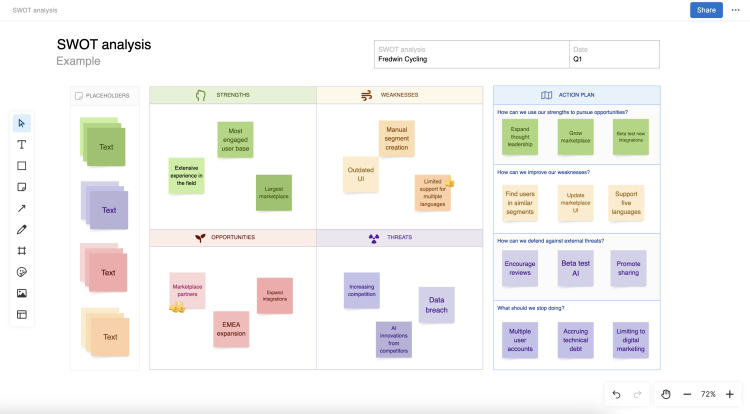
Start using this template now
Market research is not a one-time endeavor. It is something to continually invest in as conditions change and your product grows. But the insights you gain as a product manager should more than make up for the effort that conducting market research requires. When you are able to paint a full picture of the market, you will have more clarity on how your product fits into it.
FAQs about how to do market research
What does a market research analyst do?
A market research analyst gathers and analyzes data about market trends, consumer preferences, and competitive landscapes — helping businesses make informed decisions. This role is crucial for organizations looking to understand their target audience, assess demand for products or services, and develop effective marketing and business strategies.
How can product managers define their target market?
Product managers can define their target market through research, analysis, and a deep understanding of their potential customers. This entails conducting market research, creating customer personas, gathering direct and indirect feedback from prospective customers, and analyzing competitors.
What's the difference between primary and secondary research?
Primary research involves gathering new data directly from your target audience through surveys, interviews, or empathy sessions . Secondary research includes analyzing existing data collected from other sources such as reports, publications, or studies.
What questions should a product manager ask when conducting market research?
Understanding your market is core to deciding what you want to deliver and the value it will bring. Here are some essential questions to get you started:
What problems do potential customers face and how can your product help?
Who are the target customers and what do they need?
Who are your competitors and how can you stand out ?
What market trends and opportunities can you leverage?
What is the right price and value proposition for your product?
How can customers easily access and buy your product?
What might prevent customers from adopting your product, and how can you overcome those barriers?
How can you gather and use customer feedback for improvements?
- What is a business model?
- What is customer experience?
- What is the Complete Product Experience (CPE)?
- What is a customer journey map?
- What is product-led growth?
- What are the types of business transformation?
- What is enterprise transformation?
- What is digital transformation?
- What is the role of product management in enterprise transformation?
- What is a Minimum Viable Product (MVP)?
- What is a Minimum Lovable Product (MLP)?
- What is product vision?
- How to set product strategy
- What is product-market fit?
- What is product differentiation?
- How to position your product
- How to price your product
- What are product goals and initiatives?
- How to set product goals
- How to set product initiatives
- What is product value?
- What is value-based product development?
- Introduction to marketing strategy
- Introduction to marketing templates
- What is a marketing strategy?
- How to set marketing goals
- Marketing vs. advertising
- What is a creative brief?
- How to define buyer personas
- Understanding the buyer's journey
- What is competitive differentiation?
- 10Ps marketing matrix
- 2x2 prioritization matrix
- Business model
- Customer journey map
- Decision log
- Decision tree
- Fit gap analysis
- Gap analysis
- Lean canvas
- Marketing strategy
- Opportunity canvas
- Porter's 5 forces
- Pricing and packaging research
- Pricing plan chart
- Pricing strategies (Kotler)
- Product positioning
- Product vision
- Segment profile
- SMART goals
- Strategic roadmap
- Strategy mountain
- SWOT analysis
- Value proposition
- VMOST analysis
- Working backwards
- Collections: Business model
- Collections: SWOT
- Collections: Objectives and key results (OKR)
- Collections: Product positioning
- Collections: Market positioning
- Collections: Marketing strategy
- Collections: Marketing messaging
- What is product discovery?
- How to define customer personas
- How to research competitors
- How to gather customer feedback
- Asking the right questions to drive innovation
- Approaches table
- Customer empathy map
- Customer interview
Customer research plan
- PESTLE analysis
- Problem framing
- Product comparison chart
- Pros and cons
- Target audience
- Collections: Customer research
- Collections: Competitor analysis
- Collections: Marketing competitor analysis
- How to brainstorm product ideas
- Brainstorming techniques for product builders
- Why product teams need an internal knowledge hub
- Why product teams need virtual whiteboarding software
- What is idea management?
- 4 steps for product ideation
- How to estimate the value of new product ideas
- How to prioritize product ideas
- What is idea management software?
- Introduction to marketing idea management
- How to gather marketing feedback from teammates
- Brainstorming new marketing ideas
- How to estimate the value of new marketing ideas
- Brainstorming meeting
- Brainstorming session
- Concept map
- Data flow diagram
- Fishbone diagram
- Ideas portal guide
- Jobs to be done
- Process flow diagram
- Proof of concept
- Sticky note pack
- User story map
- Workflow diagram
- Roadmapping: Your starter guide
- Business roadmap
- Features roadmap
- Innovation roadmap
- Marketing roadmap
- Product roadmap
- Product portfolio roadmap
- Project roadmap
- Strategy roadmap
- Technology roadmap
- How to choose a product roadmap tool
- What to include on your product roadmap
- How to visualize data on your product roadmap
- What milestones should be included on a roadmap?
- How often should roadmap planning happen?
- How to build a roadmap for a new product
- How to build an annual product roadmap
- How to build a brilliant roadmap
- How to customize the right roadmap for your audience
- How to build an agile roadmap
- Product roadmap examples
- How to report on progress against your roadmap
- How to communicate your product roadmap to customers
- What is a content marketing roadmap?
- What is a digital marketing roadmap?
- What is an integrated marketing roadmap?
- What is a go-to-market roadmap?
- What is a portfolio marketing roadmap?
- How to choose a marketing roadmap tool
- Epics roadmap
- Now, Next, Later roadmap
- Portfolio roadmap
- Release roadmap
- Collections: Product roadmap
- Collections: Product roadmap presentation
- Collections: Marketing roadmap
- What is product planning?
- How to diagram product use cases
- How product managers use Gantt charts
- How to use a digital whiteboard for product planning
- Introduction to release management
- How to plan product releases across teams
- What is a product backlog?
- Product backlog vs. release backlog vs. sprint backlog
- How to refine the product backlog
- Capacity planning for product managers
- What is requirements management?
- What is a market requirements document (MRD)?
- How to manage your product requirements document (PRD)
- What is a product feature?
- What is user story mapping?
- How to prioritize product features
- Common product prioritization frameworks
- JTBD prioritization framework
- Introduction to marketing plans
- What is a marketing plan?
- How to create a marketing plan
- What is a digital marketing plan?
- What is a content marketing plan?
- Why is content marketing important?
- What is a social media plan?
- How to create a marketing budget
- 2023 monthly calendar
- 2024 monthly calendar
- Feature requirement
- Kanban board
- Market requirements document
- Problem statement
- Product requirements document
- SAFe® Program board
- Stakeholder analysis
- Stakeholder map
- Timeline diagram
- Collections: Product development process
- Collections: MRD
- Collections: PRD
- Collections: Gantt chart
- Collections: User story
- Collections: User story mapping
- Collections: Feature definition checklist
- Collections: Feature prioritization templates
- Collections: Marketing plan templates
- Collections: Marketing calendar templates
- Product design basics
- What is user experience design?
- What is the role of a UX designer?
- What is the role of a UX manager?
- How to use a wireframe in product management
- Wireframe vs. mockup vs. prototype
- Analytics dashboard wireframe
- Product homepage wireframe
- Signup wireframe
- Collections: Creative brief
- Common product development methodologies
- Common agile development methodologies
- What is agile product management?
- What is agile software development?
- What is agile project management?
- What is the role of a software engineer?
- What is waterfall product management?
- What is agile transformation?
- Agile vs. lean
- Agile vs. waterfall
- What is an agile roadmap?
- What is an agile retrospective?
- Best practices of agile development teams
- What is a burndown chart?
- What is issue tracking?
- What is unit testing?
- Introduction to agile metrics
- Agile glossary
- What is kanban?
- How development teams implement kanban
- How is kanban used by product managers?
- How to set up a kanban board
- Kanban vs. scrum
- What is scrum?
- What are scrum roles?
- What is a scrum master?
- What is the role of a product manager in scrum?
- What is a sprint?
- What is a sprint planning meeting?
- What is a daily standup?
- What is a sprint review?
- Product release vs. sprint in scrum
- Themes, epics, stories, and tasks
- How to implement scrum
- How to choose a scrum certification
- What is the Scaled Agile Framework®?
- What is the role of a product manager in SAFe®?
- SAFe® PI planning
- SAFe® PI retrospective
- SAFe® Sprint planning
- Sprint planning
- Sprint retrospective
- Sprint retrospective meeting
- UML class diagram
- Collections: Sprint retrospective
- How to test your product before launch
- What is a go-to-market strategy?
- How to write excellent release notes
- How to plan a marketing launch
- Knowledge base article
- Product launch plan
- Product updates
- Release notes
- Collections: Product launch checklist
- Collections: Marketing launch checklist
- How to make data-driven product decisions
- How to measure product value
- What is product analytics?
- What are product metrics?
- What is a product?
- What is product development?
- What is product management?
- What is the role of a product manager?
- What is portfolio product management?
- What is product operations?
- What are the stages of product development?
- What is the product lifecycle?
- What is a product management maturity model?
- What is product development software?
- How to create internal product documentation
- What to include in an internal product documentation hub
- Internal vs. external product documentation
- How to build a product knowledge base
- Introduction to marketing methods
- What is agile marketing?
- What is digital marketing?
- What is product marketing?
- What is social media marketing?
- What is B2B marketing?
- Collections: Product management
- How to structure your product team meeting
- 15 tips for running effective product team meetings
- Daily standup meeting
- Meeting agenda
- Meeting notes
- Product backlog refinement meeting
- Product feature kickoff meeting
- Product operations meeting
- Product strategy meeting
- Sprint planning meeting
- What are the types of product managers?
- 10 skills to succeed as a product manager
- Common product management job titles
- What does a product manager do each day?
- What is the role of a product operations manager?
- What is the role of a program manager?
- How to become a product manager
- How to prepare for a product manager interview
- Interview questions for product managers
- Typical salary for product managers
- Tips for new product managers
- How to choose a product management certification
- Introduction to marketing
- What are some marketing job titles?
- What is the role of a marketing manager?
- What is the role of a product marketing manager?
- How are marketing teams organized?
- Which tools do marketers use?
- Interview questions for marketing managers
- Typical salary for marketing managers
- How to make a career switch into marketing
- Job interview
- Negotiating an offer
- Product manager resume
- Collections: Product manager resume
- How to structure your product development team
- Best practices for managing a product development team
- Which tools do product managers use?
- How to streamline your product management tools
- Tips for effective collaboration between product managers and engineers
- How do product managers work with other teams?
- How product managers achieve stakeholder alignment
- Creative brief
- Marketing calendar
- Organizational chart
- Presentation slides
- Process improvement
- Collections: Product management meeting
- Collections: Diagrams, flowcharts for product teams
- Collections: Whiteboarding
- Collections: Templates to run product meetings
- Product development definitions
- Marketing definitions
Popular templates
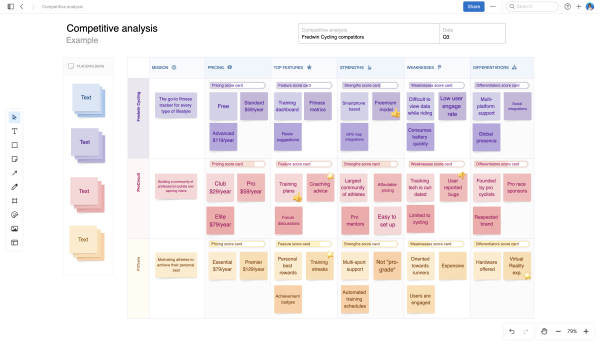
See how your product stacks up against competitors.
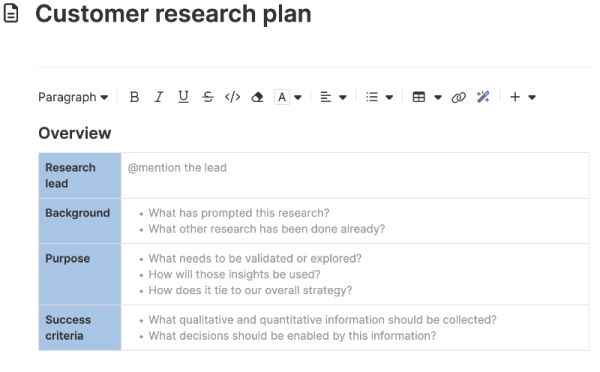
Clarify research goals and select your methods.

Personas template
Distill the most impactful attributes and behaviors of your users.
- Privacy policy
- Terms of service
Learn / Blog / Article
Back to blog
How to do market research in 4 steps: a lean approach to marketing research
From pinpointing your target audience and assessing your competitive advantage, to ongoing product development and customer satisfaction efforts, market research is a practice your business can only benefit from.
Learn how to conduct quick and effective market research using a lean approach in this article full of strategies and practical examples.

Last updated
Reading time.

A comprehensive (and successful) business strategy is not complete without some form of market research—you can’t make informed and profitable business decisions without truly understanding your customer base and the current market trends that drive your business.
In this article, you’ll learn how to conduct quick, effective market research using an approach called 'lean market research'. It’s easier than you might think, and it can be done at any stage in a product’s lifecycle.
How to conduct lean market research in 4 steps
What is market research, why is market research so valuable, advantages of lean market research, 4 common market research methods, 5 common market research questions, market research faqs.
We’ll jump right into our 4-step approach to lean market research. To show you how it’s done in the real world, each step includes a practical example from Smallpdf , a Swiss company that used lean market research to reduce their tool’s error rate by 75% and boost their Net Promoter Score® (NPS) by 1%.
Research your market the lean way...
From on-page surveys to user interviews, Hotjar has the tools to help you scope out your market and get to know your customers—without breaking the bank.
The following four steps and practical examples will give you a solid market research plan for understanding who your users are and what they want from a company like yours.
1. Create simple user personas
A user persona is a semi-fictional character based on psychographic and demographic data from people who use websites and products similar to your own. Start by defining broad user categories, then elaborate on them later to further segment your customer base and determine your ideal customer profile .
How to get the data: use on-page or emailed surveys and interviews to understand your users and what drives them to your business.
How to do it right: whatever survey or interview questions you ask, they should answer the following questions about the customer:
Who are they?
What is their main goal?
What is their main barrier to achieving this goal?
Pitfalls to avoid:
Don’t ask too many questions! Keep it to five or less, otherwise you’ll inundate them and they’ll stop answering thoughtfully.
Don’t worry too much about typical demographic questions like age or background. Instead, focus on the role these people play (as it relates to your product) and their goals.
How Smallpdf did it: Smallpdf ran an on-page survey for a couple of weeks and received 1,000 replies. They learned that many of their users were administrative assistants, students, and teachers.

Next, they used the survey results to create simple user personas like this one for admins:
Who are they? Administrative Assistants.
What is their main goal? Creating Word documents from a scanned, hard-copy document or a PDF where the source file was lost.
What is their main barrier to achieving it? Converting a scanned PDF doc to a Word file.
💡Pro tip: Smallpdf used Hotjar Surveys to run their user persona survey. Our survey tool helped them avoid the pitfalls of guesswork and find out who their users really are, in their own words.
You can design a survey and start running it in minutes with our easy-to-use drag and drop builder. Customize your survey to fit your needs, from a sleek one-question pop-up survey to a fully branded questionnaire sent via email.
We've also created 40+ free survey templates that you can start collecting data with, including a user persona survey like the one Smallpdf used.
2. Conduct observational research
Observational research involves taking notes while watching someone use your product (or a similar product).
Overt vs. covert observation
Overt observation involves asking customers if they’ll let you watch them use your product. This method is often used for user testing and it provides a great opportunity for collecting live product or customer feedback .
Covert observation means studying users ‘in the wild’ without them knowing. This method works well if you sell a type of product that people use regularly, and it offers the purest observational data because people often behave differently when they know they’re being watched.
Tips to do it right:
Record an entry in your field notes, along with a timestamp, each time an action or event occurs.
Make note of the users' workflow, capturing the ‘what,’ ‘why,’ and ‘for whom’ of each action.

Don’t record identifiable video or audio data without consent. If recording people using your product is helpful for achieving your research goal, make sure all participants are informed and agree to the terms.
Don’t forget to explain why you’d like to observe them (for overt observation). People are more likely to cooperate if you tell them you want to improve the product.
💡Pro tip: while conducting field research out in the wild can wield rewarding results, you can also conduct observational research remotely. Hotjar Recordings is a tool that lets you capture anonymized user sessions of real people interacting with your website.
Observe how customers navigate your pages and products to gain an inside look into their user behavior . This method is great for conducting exploratory research with the purpose of identifying more specific issues to investigate further, like pain points along the customer journey and opportunities for optimizing conversion .
With Hotjar Recordings you can observe real people using your site without capturing their sensitive information
How Smallpdf did it: here’s how Smallpdf observed two different user personas both covertly and overtly.
Observing students (covert): Kristina Wagner, Principle Product Manager at Smallpdf, went to cafes and libraries at two local universities and waited until she saw students doing PDF-related activities. Then she watched and took notes from a distance. One thing that struck her was the difference between how students self-reported their activities vs. how they behaved (i.e, the self-reporting bias). Students, she found, spent hours talking, listening to music, or simply staring at a blank screen rather than working. When she did find students who were working, she recorded the task they were performing and the software they were using (if she recognized it).
Observing administrative assistants (overt): Kristina sent emails to admins explaining that she’d like to observe them at work, and she asked those who agreed to try to batch their PDF work for her observation day. While watching admins work, she learned that they frequently needed to scan documents into PDF-format and then convert those PDFs into Word docs. By observing the challenges admins faced, Smallpdf knew which products to target for improvement.
“Data is really good for discovery and validation, but there is a bit in the middle where you have to go and find the human.”
3. Conduct individual interviews
Interviews are one-on-one conversations with members of your target market. They allow you to dig deep and explore their concerns, which can lead to all sorts of revelations.
Listen more, talk less. Be curious.
Act like a journalist, not a salesperson. Rather than trying to talk your company up, ask people about their lives, their needs, their frustrations, and how a product like yours could help.
Ask "why?" so you can dig deeper. Get into the specifics and learn about their past behavior.
Record the conversation. Focus on the conversation and avoid relying solely on notes by recording the interview. There are plenty of services that will transcribe recorded conversations for a good price (including Hotjar!).
Avoid asking leading questions , which reveal bias on your part and pushes respondents to answer in a certain direction (e.g. “Have you taken advantage of the amazing new features we just released?).
Don't ask loaded questions , which sneak in an assumption which, if untrue, would make it impossible to answer honestly. For example, we can’t ask you, “What did you find most useful about this article?” without asking whether you found the article useful in the first place.
Be cautious when asking opinions about the future (or predictions of future behavior). Studies suggest that people aren’t very good at predicting their future behavior. This is due to several cognitive biases, from the misguided exceptionalism bias (we’re good at guessing what others will do, but we somehow think we’re different), to the optimism bias (which makes us see things with rose-colored glasses), to the ‘illusion of control’ (which makes us forget the role of randomness in future events).
How Smallpdf did it: Kristina explored her teacher user persona by speaking with university professors at a local graduate school. She learned that the school was mostly paperless and rarely used PDFs, so for the sake of time, she moved on to the admins.
A bit of a letdown? Sure. But this story highlights an important lesson: sometimes you follow a lead and come up short, so you have to make adjustments on the fly. Lean market research is about getting solid, actionable insights quickly so you can tweak things and see what works.
💡Pro tip: to save even more time, conduct remote interviews using an online user research service like Hotjar Engage , which automates the entire interview process, from recruitment and scheduling to hosting and recording.
You can interview your own customers or connect with people from our diverse pool of 200,000+ participants from 130+ countries and 25 industries. And no need to fret about taking meticulous notes—Engage will automatically transcribe the interview for you.
4. Analyze the data (without drowning in it)
The following techniques will help you wrap your head around the market data you collect without losing yourself in it. Remember, the point of lean market research is to find quick, actionable insights.
A flow model is a diagram that tracks the flow of information within a system. By creating a simple visual representation of how users interact with your product and each other, you can better assess their needs.

You’ll notice that admins are at the center of Smallpdf’s flow model, which represents the flow of PDF-related documents throughout a school. This flow model shows the challenges that admins face as they work to satisfy their own internal and external customers.
Affinity diagram
An affinity diagram is a way of sorting large amounts of data into groups to better understand the big picture. For example, if you ask your users about their profession, you’ll notice some general themes start to form, even though the individual responses differ. Depending on your needs, you could group them by profession, or more generally by industry.

We wrote a guide about how to analyze open-ended questions to help you sort through and categorize large volumes of response data. You can also do this by hand by clipping up survey responses or interview notes and grouping them (which is what Kristina does).
“For an interview, you will have somewhere between 30 and 60 notes, and those notes are usually direct phrases. And when you literally cut them up into separate pieces of paper and group them, they should make sense by themselves.”
Pro tip: if you’re conducting an online survey with Hotjar, keep your team in the loop by sharing survey responses automatically via our Slack and Microsoft Team integrations. Reading answers as they come in lets you digest the data in pieces and can help prepare you for identifying common themes when it comes time for analysis.
Hotjar lets you easily share survey responses with your team
Customer journey map
A customer journey map is a diagram that shows the way a typical prospect becomes a paying customer. It outlines their first interaction with your brand and every step in the sales cycle, from awareness to repurchase (and hopefully advocacy).

The above customer journey map , created by our team at Hotjar, shows many ways a customer might engage with our tool. Your map will be based on your own data and business model.
📚 Read more: if you’re new to customer journey maps, we wrote this step-by-step guide to creating your first customer journey map in 2 and 1/2 days with free templates you can download and start using immediately.
Next steps: from research to results
So, how do you turn market research insights into tangible business results? Let’s look at the actions Smallpdf took after conducting their lean market research: first they implemented changes, then measured the impact.

Implement changes
Based on what Smallpdf learned about the challenges that one key user segment (admins) face when trying to convert PDFs into Word files, they improved their ‘PDF to Word’ conversion tool.
We won’t go into the details here because it involves a lot of technical jargon, but they made the entire process simpler and more straightforward for users. Plus, they made it so that their system recognized when you drop a PDF file into their ‘Word to PDF’ converter instead of the ‘PDF to Word’ converter, so users wouldn’t have to redo the task when they made that mistake.
In other words: simple market segmentation for admins showed a business need that had to be accounted for, and customers are happier overall after Smallpdf implemented an informed change to their product.
Measure results
According to the Lean UX model, product and UX changes aren’t retained unless they achieve results.
Smallpdf’s changes produced:
A 75% reduction in error rate for the ‘PDF to Word’ converter
A 1% increase in NPS
Greater confidence in the team’s marketing efforts
"With all the changes said and done, we've cut our original error rate in four, which is huge. We increased our NPS by +1%, which isn't huge, but it means that of the users who received a file, they were still slightly happier than before, even if they didn't notice that anything special happened at all.”
Subscribe to fresh and free monthly insights.
Over 50,000 people interested in UX, product, digital empathy, and beyond, receive our newsletter every month. No spam, just thoughtful perspectives from a range of experts, new approaches to remote work, and loads more valuable insights. If that floats your boat, why not become a subscriber?
I have read and accepted the message outlined here: Hotjar uses the information you provide to us to send you relevant content, updates and offers from time to time. You can unsubscribe at any time by clicking the link at the bottom of any email.
Market research (or marketing research) is any set of techniques used to gather information and better understand a company’s target market. This might include primary research on brand awareness and customer satisfaction or secondary market research on market size and competitive analysis. Businesses use this information to design better products, improve user experience, and craft a marketing strategy that attracts quality leads and improves conversion rates.
David Darmanin, one of Hotjar’s founders, launched two startups before Hotjar took off—but both companies crashed and burned. Each time, he and his team spent months trying to design an amazing new product and user experience, but they failed because they didn’t have a clear understanding of what the market demanded.
With Hotjar, they did things differently . Long story short, they conducted market research in the early stages to figure out what consumers really wanted, and the team made (and continues to make) constant improvements based on market and user research.
Without market research, it’s impossible to understand your users. Sure, you might have a general idea of who they are and what they need, but you have to dig deep if you want to win their loyalty.
Here’s why research matters:
Obsessing over your users is the only way to win. If you don’t care deeply about them, you’ll lose potential customers to someone who does.
Analytics gives you the ‘what’, while research gives you the ‘why’. Big data, user analytics , and dashboards can tell you what people do at scale, but only research can tell you what they’re thinking and why they do what they do. For example, analytics can tell you that customers leave when they reach your pricing page, but only research can explain why.
Research beats assumptions, trends, and so-called best practices. Have you ever watched your colleagues rally behind a terrible decision? Bad ideas are often the result of guesswork, emotional reasoning, death by best practices , and defaulting to the Highest Paid Person’s Opinion (HiPPO). By listening to your users and focusing on their customer experience , you’re less likely to get pulled in the wrong direction.
Research keeps you from planning in a vacuum. Your team might be amazing, but you and your colleagues simply can’t experience your product the way your customers do. Customers might use your product in a way that surprises you, and product features that seem obvious to you might confuse them. Over-planning and refusing to test your assumptions is a waste of time, money, and effort because you’ll likely need to make changes once your untested business plan gets put into practice.
Lean User Experience (UX) design is a model for continuous improvement that relies on quick, efficient research to understand customer needs and test new product features.
Lean market research can help you become more...
Efficient: it gets you closer to your customers, faster.
Cost-effective: no need to hire an expensive marketing firm to get things started.
Competitive: quick, powerful insights can place your products on the cutting edge.
As a small business or sole proprietor, conducting lean market research is an attractive option when investing in a full-blown research project might seem out of scope or budget.
There are lots of different ways you could conduct market research and collect customer data, but you don’t have to limit yourself to just one research method. Four common types of market research techniques include surveys, interviews, focus groups, and customer observation.
Which method you use may vary based on your business type: ecommerce business owners have different goals from SaaS businesses, so it’s typically prudent to mix and match these methods based on your particular goals and what you need to know.
1. Surveys: the most commonly used
Surveys are a form of qualitative research that ask respondents a short series of open- or closed-ended questions, which can be delivered as an on-screen questionnaire or via email. When we asked 2,000 Customer Experience (CX) professionals about their company’s approach to research , surveys proved to be the most commonly used market research technique.
What makes online surveys so popular?
They’re easy and inexpensive to conduct, and you can do a lot of data collection quickly. Plus, the data is pretty straightforward to analyze, even when you have to analyze open-ended questions whose answers might initially appear difficult to categorize.
We've built a number of survey templates ready and waiting for you. Grab a template and share with your customers in just a few clicks.
💡 Pro tip: you can also get started with Hotjar AI for Surveys to create a survey in mere seconds . Just enter your market research goal and watch as the AI generates a survey and populates it with relevant questions.
Once you’re ready for data analysis, the AI will prepare an automated research report that succinctly summarizes key findings, quotes, and suggested next steps.

An example research report generated by Hotjar AI for Surveys
2. Interviews: the most insightful
Interviews are one-on-one conversations with members of your target market. Nothing beats a face-to-face interview for diving deep (and reading non-verbal cues), but if an in-person meeting isn’t possible, video conferencing is a solid second choice.
Regardless of how you conduct it, any type of in-depth interview will produce big benefits in understanding your target customers.
What makes interviews so insightful?
By speaking directly with an ideal customer, you’ll gain greater empathy for their experience , and you can follow insightful threads that can produce plenty of 'Aha!' moments.
3. Focus groups: the most unreliable
Focus groups bring together a carefully selected group of people who fit a company’s target market. A trained moderator leads a conversation surrounding the product, user experience, or marketing message to gain deeper insights.
What makes focus groups so unreliable?
If you’re new to market research, we wouldn’t recommend starting with focus groups. Doing it right is expensive , and if you cut corners, your research could fall victim to all kinds of errors. Dominance bias (when a forceful participant influences the group) and moderator style bias (when different moderator personalities bring about different results in the same study) are two of the many ways your focus group data could get skewed.
4. Observation: the most powerful
During a customer observation session, someone from the company takes notes while they watch an ideal user engage with their product (or a similar product from a competitor).
What makes observation so clever and powerful?
‘Fly-on-the-wall’ observation is a great alternative to focus groups. It’s not only less expensive, but you’ll see people interact with your product in a natural setting without influencing each other. The only downside is that you can’t get inside their heads, so observation still isn't a recommended replacement for customer surveys and interviews.
The following questions will help you get to know your users on a deeper level when you interview them. They’re general questions, of course, so don’t be afraid to make them your own.
1. Who are you and what do you do?
How you ask this question, and what you want to know, will vary depending on your business model (e.g. business-to-business marketing is usually more focused on someone’s profession than business-to-consumer marketing).
It’s a great question to start with, and it’ll help you understand what’s relevant about your user demographics (age, race, gender, profession, education, etc.), but it’s not the be-all-end-all of market research. The more specific questions come later.
2. What does your day look like?
This question helps you understand your users’ day-to-day life and the challenges they face. It will help you gain empathy for them, and you may stumble across something relevant to their buying habits.
3. Do you ever purchase [product/service type]?
This is a ‘yes or no’ question. A ‘yes’ will lead you to the next question.
4. What problem were you trying to solve or what goal were you trying to achieve?
This question strikes to the core of what someone’s trying to accomplish and why they might be willing to pay for your solution.
5. Take me back to the day when you first decided you needed to solve this kind of problem or achieve this goal.
This is the golden question, and it comes from Adele Revella, Founder and CEO of Buyer Persona Institute . It helps you get in the heads of your users and figure out what they were thinking the day they decided to spend money to solve a problem.
If you take your time with this question, digging deeper where it makes sense, you should be able to answer all the relevant information you need to understand their perspective.
“The only scripted question I want you to ask them is this one: take me back to the day when you first decided that you needed to solve this kind of problem or achieve this kind of a goal. Not to buy my product, that’s not the day. We want to go back to the day that when you thought it was urgent and compelling to go spend money to solve a particular problem or achieve a goal. Just tell me what happened.”
— Adele Revella , Founder/CEO at Buyer Persona Institute
Bonus question: is there anything else you’d like to tell me?
This question isn’t just a nice way to wrap it up—it might just give participants the opportunity they need to tell you something you really need to know.
That’s why Sarah Doody, author of UX Notebook , adds it to the end of her written surveys.
“I always have a last question, which is just open-ended: “Is there anything else you would like to tell me?” And sometimes, that’s where you get four paragraphs of amazing content that you would never have gotten if it was just a Net Promoter Score [survey] or something like that.”
What is the difference between qualitative and quantitative research?
Qualitative research asks questions that can’t be reduced to a number, such as, “What is your job title?” or “What did you like most about your customer service experience?”
Quantitative research asks questions that can be answered with a numeric value, such as, “What is your annual salary?” or “How was your customer service experience on a scale of 1-5?”
→ Read more about the differences between qualitative and quantitative user research .
How do I do my own market research?
You can do your own quick and effective market research by
Surveying your customers
Building user personas
Studying your users through interviews and observation
Wrapping your head around your data with tools like flow models, affinity diagrams, and customer journey maps
What is the difference between market research and user research?
Market research takes a broad look at potential customers—what problems they’re trying to solve, their buying experience, and overall demand. User research, on the other hand, is more narrowly focused on the use (and usability ) of specific products.
What are the main criticisms of market research?
Many marketing professionals are critical of market research because it can be expensive and time-consuming. It’s often easier to convince your CEO or CMO to let you do lean market research rather than something more extensive because you can do it yourself. It also gives you quick answers so you can stay ahead of the competition.
Do I need a market research firm to get reliable data?
Absolutely not! In fact, we recommend that you start small and do it yourself in the beginning. By following a lean market research strategy, you can uncover some solid insights about your clients. Then you can make changes, test them out, and see whether the results are positive. This is an excellent strategy for making quick changes and remaining competitive.
Net Promoter, Net Promoter System, Net Promoter Score, NPS, and the NPS-related emoticons are registered trademarks of Bain & Company, Inc., Fred Reichheld, and Satmetrix Systems, Inc.
Related articles

6 traits of top marketing leaders (and how to cultivate them in yourself)
Stepping into a marketing leadership role can stir up a mix of emotions: excitement, optimism, and, often, a gnawing doubt. "Do I have the right skills to truly lead and inspire?" If you've ever wrestled with these uncertainties, you're not alone.
Hotjar team

The 7 best BI tools for marketers in 2024 (and how to use them)
Whether you're sifting through campaign attribution data or reviewing performance reports from different sources, extracting meaningful business insights from vast amounts of data is an often daunting—yet critical—task many marketers face. So how do you efficiently evaluate your results and communicate key learnings?
This is where business intelligence (BI) tools come in, transforming raw data into actionable insights that drive informed, customer-centric decisions.

6 marketing trends that will shape the future of ecommerce in 2023
Today, marketing trends evolve at the speed of technology. Ecommerce businesses that fail to update their marketing strategies to meet consumers where they are in 2023 will be left out of the conversations that drive brand success.

Geoff Whiting
Why is market research important? Here are 7 reasons

Doing your own market research on a regular basis is essential for keeping up with current market trends and maintaining a competitive edge. Whether you are starting a new business, expanding, or developing new products, conducting market research is essential. It helps you to understand your target market, increase sales, and spearhead business growth. In this article, we share 7 reasons why you should be investing in market research .
Use Netigate to send your market research surveys .
1. Identify new customers
In order to identify potential new customers, you must first understand who your customers are. You will also need to know key demographics.
When looking at your product or service, it’s important to consider questions such as:
- Who will use your product or service?
- What is the age range of your customers?
- What is their income level, marital status, and geographical location?
Using market research to understand these factors will enable you to target customers more effectively.
- Create surveys based on our templates
- Send surveys via email, links, API or individual logins
- Analyse responses with filters & AI
2. Get to know your existing customers
Similar to the above point, you should also take the time to understand who your existing customers are. Here are some questions to ask:
- Why do your customers choose your products over your competition?
- How do your customers use your products?
- How do your products solve a challenge?
- Who or what influences their purchase decisions?
- What do your customers enjoy doing, watching, and reading?
Understanding how your existing customers use your products as well as what challenges your products solve will help businesses improve their products as well as identify upsell opportunities with existing customers.
3. Set realistic targets for your business
Now that you are armed with information about your target customers and existing customers, you can use this data to set achievable and realistic goals for continuous improvement and business growth.
Being customer-centric in your approach is essential in today’s business climate. The most common approach in market research is to use an STP model: Segmentation – Targeting – Positioning.
Segmentation : Who will your product appeal to in terms of demographic, location, or other factors?
Targeting : How can you target and reach those sectors that your products appeal to?
Positioning : How can you position yourself in front of your competitors as your target market’s choice?
4. Develop new and effective strategies
Data from market research will help you to make more informed decisions. For example, relating to pricing, distribution channels, marketing mediums, or to identify opportunities to introduce a new product or service. These results will also help you to make more informed decisions about your existing operations and activities.
- Should you expand or reduce?
- Is there room in your current operations to diversify?
- Are you targeting the right audience with your marketing activities
Casio used market research to get better insights on customers & resellers and adjusted the marketing strategies to be more effective.

5. Solve your biggest business challenges
If you have already identified a problem in your business, conducting market research will help you determine the source of the issue. For example, you can determine if a new competitor has entered the market or if brand awareness has fallen short, causing a decrease in sales. There are several types of market research that can help you identify different shortcomings: brand research, consumer research, product development and usability testing, consumer research, and many other areas.
Get started with our free market research survey templates.
6. Investigate expansion opportunities
Market research helps you identify areas for possible business expansion. Given that it offers the opportunity to test markets to determine if there is room for a new product or service. You can also conduct market research to find the best location to open a new store.
7. Identify how to expand your offering
Market research may help you discover new markets that are under-serviced or in demand. For example, you can identify changing market trends due to new housing construction, increased levels of education, or other changes that will bring new opportunities for your business.
All in all, market research isn’t just for new startup businesses. Businesses of all shapes, sizes, scope, industry and experience levels can benefit from market research. Market research can help you to learn about new and existing customers, identify issues and solve problems, and even help explore new opportunities that pave the way for business growth.

How to use feedback software in event planning
Learn how survey software can be used as a tool for helping you in your event planning.

Your guide to conducting a website feedback survey
This article summarises everything you need to know about website feedback surveys and helps you to implement them step-by-step on your webpage.

Your guide to panel research – what you need to know
This article explores panel research and how it works within market research. Market research is…
Sign up to our monthly newsletter and get the latest insights
By submitting the form, you agree to Netigate's terms and conditions and order processing agreement and acknowledge that you have read Netigate's privacy policy .
✅ Get the latest insights, reports, and eBooks ✅ See feedback management tips and best practices ✅ Be the first to hear about platform enhancements and features
Almost there!
Please confirm your email address by clicking the link in the email we just sent you.
Quick start guide to Text Analysis
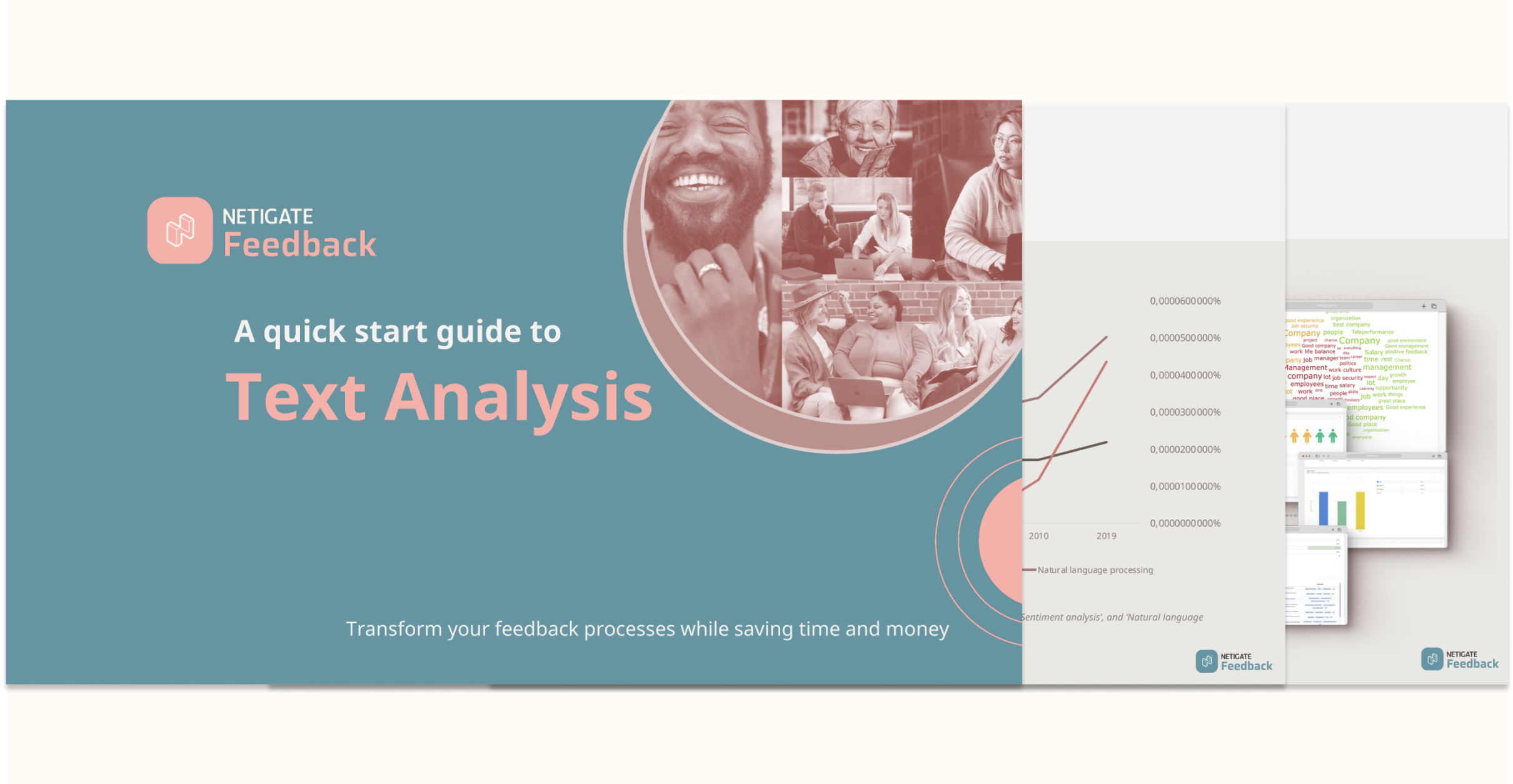
But first, cookies 🍪
Privacy overview.

How to do Market Analysis in 6 Easy Steps

Knowing how to do market analysis is pivotal for many roles, benefiting any organization, regardless of its size, scope, or sector.
Regular market analysis levels up your individual ability to spot potential opportunities, stay on top of current trends, and gives you insights into the competitive landscape .
This article will cover why you need to analyze a market frequently and shows you how to do a basic market analysis in 6 straightforward steps.
What is a market analysis?
Market analysis is the process of gathering data about a target market . It examines the competitive landscape, consumers, and conditions that impact the marketplace.
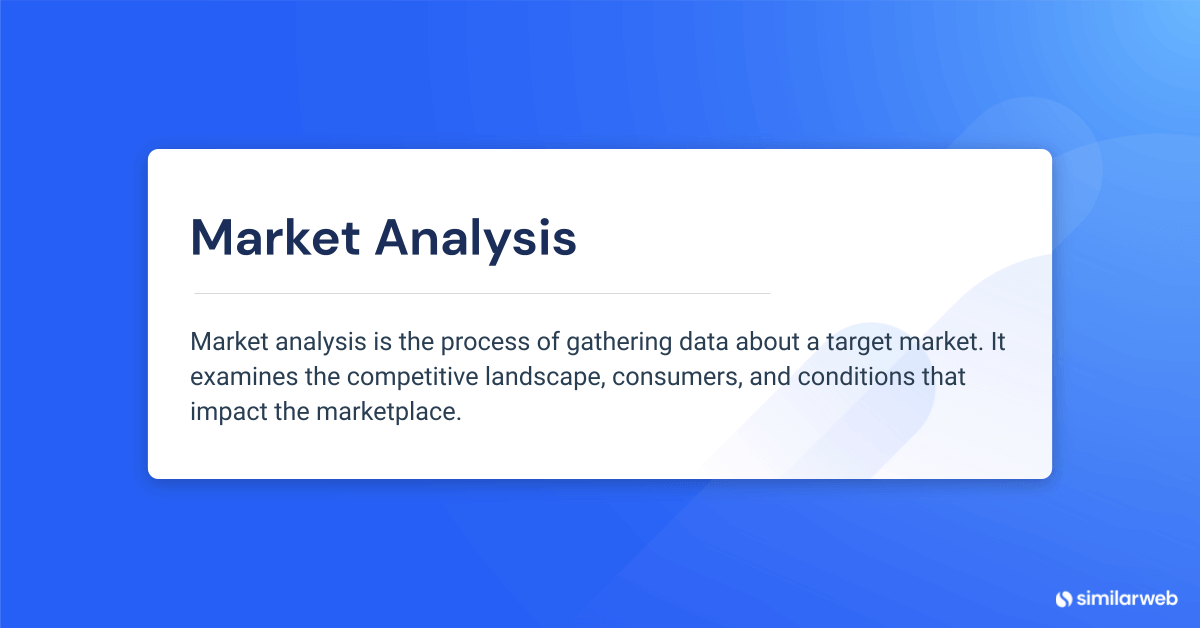
The benefits of market analysis
Here are eight reasons why a regular market analysis is beneficial:
- Understand the competitive landscape
- Spot trends in your market
- Uncover opportunities for growth or diversification
- Reduce either risk or cost for launching new products or services
- Develop a deeper understanding of a target audience
- Enhance marketing efforts or discover ways to change
- Analyze business performance within a market
- Identify new segments of a market to target
Why you should conduct a market analysis
Aside from the benefits we’ve already listed, reviewing and redoing your market analysis regularly is important . Here’s why.
- Markets shift
- Consumer behaviors change
- New players enter existing markets
- Disruptive technologies and enhancements to rival offerings can shift the landscape
- External events impact market conditions that drive changes
If you already know how to do market analysis, ask yourself how frequently you undertake the task: is it annually or quarterly? And consider the time it takes and the tools you used to obtain your information.
With this in mind, we’ll walk you through the most effective market analysis methods. Showing you the steps to take, with market analysis examples, to bring these steps to life.
How to conduct a market analysis
These six steps break down how to analyze a market into easy-to-follow, digestible stages.
Before you start: Use a framework to record your findings. There are plenty of visualization tools, but a basic excel sheet will be fine if you want to keep it simple. Why? Because when you return to review this analysis and repeat this exercise, you’ll want to have everything recorded in a single place. It will save you time and make any future comparisons easier.
Step 1 – Market segmentation
What: Whether you want to enter a new market , launch a new product, or simply assess opportunities for an existing business, this first step in the market analysis process is crucial yet often overlooked.
Why: Market segmentation helps you identify the core segments of a market to target. By identifying the portion of a market your products will be suitable for, you can accurately define the market size and better understand your potential customers’ specific needs and preferences.
How: There are multiple ways you can segment a market, and the right approach will depend on your product, its customers, and its target profiles.
Here, we can see how a segment is built using Similarweb’s website segment feature. I specifically want to view the credit card sector in the US, a market made up of pure players (think Amex or Visa ) and individual players with credit card lines as one of their segments (think Wells Fargo or USAA ). By splitting up a market like this, I can analyze the areas of business I care about more for my market analysis.
So, instead of viewing data that encompasses the other lines of business the likes of Wells Fargo and the USAA handle, such as loans, I get to hone in on their credit card segments only.
This is just one example of market segmentation. You can also segment a market based on consumer needs, ideal consumer profiles, regions, and other demographic data.
Step 2 – Market sizing
What: Market sizing determines your target market’s potential volume or sales revenue. It’s an essential component of market analysis that uses either secondary or primary research to explore the actual size of the market you are in or wish to enter.
Total Addressable Market (TAM) – This gives you the complete value of the overall market and the first step in the market sizing process . Let’s say we want to analyze the US credit card market, the TAM would account for the whole of this market. Service Addressable Market (SAM) looks at potential audience volumes for a product or service in a target region. Sticking with the credit card sector example, this could be the total value of the credit card business that specifically targets the ‘poor credit rating’ segment of this market. Share of Market (SOM) – Also known as ‘service addressable market,’ it represents the proportion of your SAM that you are likely to achieve. SOM is always lower than SAM, taking a range of estimates based on the previous year’s performance or current market share + project growth to arrive at this figure.

Why: Market sizing helps businesses understand the size of their opportunity. By understanding the size and scope of a market, companies can better assess the potential profitability of the market. Tracking market share over time can also show who wins or loses at any given time.
Power-up Your Market Analysis with Similarweb Today
Market analysis example: market sizing.
Using a metric known as traffic share , we can estimate the potential market size by showing the total reachable audience you have or could have with a product or service.

Using Similarweb Industry Analysis , I can see a real-time snapshot of my market’s performance. With it, I can see the total number of people in a market (unique visitors) and establish how much of that share I have or will target this year.
When sizing a market, it’s easy to fall into the habit of analyzing the market quarterly or annually. But often, the best insights are dynamic in nature. They appear to show shifts, sometimes unexpectedly or can indicate growth and changing behaviors as the year progresses. This is why we place a high emphasis on continuing a market analysis throughout the year.
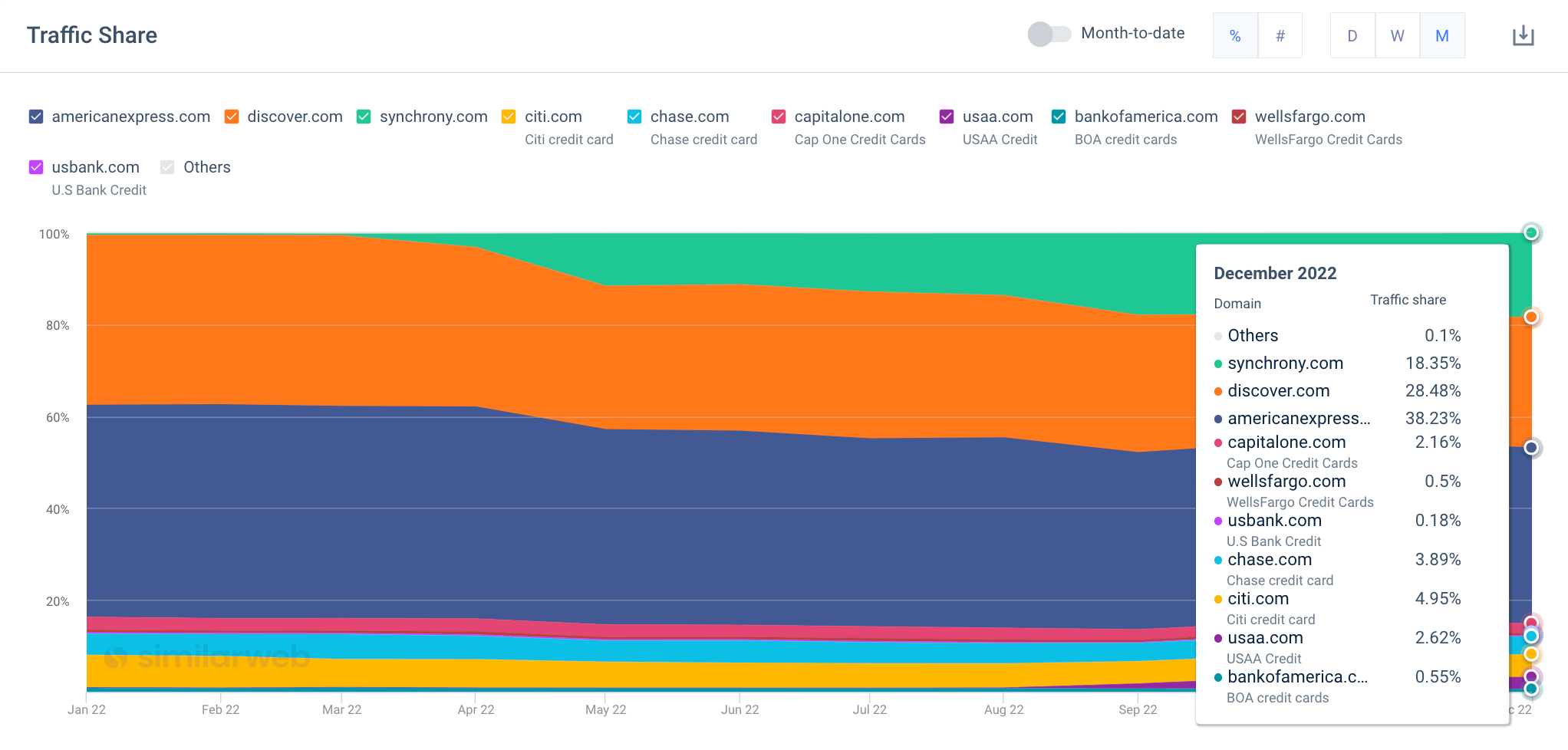
Here, we’re looking at traffic share changes over time using Similarweb’s market trends. You can see the impact of Snychrony’s growth (in green) as they gain traction, along with USAA (purple). At the start of the year, these two players had no impact on the market. By the end of 2022, they’re showing gains and would be two key competitors to track when you reach step 4 of the market analysis process.
Those analyzing a market annually would miss out on key insights that show the rise of these two emerging players. At the end of the year, they’ve already grabbed a chunk of the market and, if they continue on the same trajectory, will continue to do so in 2023.
With the right tools, you get a dynamic view of the market data you need, allowing you to change tactics when markets shift.
Step 3 – Market trends
What: Reviewing current trends is key to any good market analysis. As we all know, trends can rise and fall at a moment’s notice. This is why this activity, in particular, is one you should routinely perform.
Why: Keeping a finger on the pulse can help you adapt and flex, at the right time, in the right way. Market trends give you insights into the current market situation and potential opportunities and challenges. Doing so can help you identify areas for growth, spot potential risks, and plan effective strategies. Market trends can also provide valuable information about customer preferences, competition, and economic and technological developments. By monitoring these trends, businesses can stay ahead of the curve and make informed decisions that will benefit their bottom line.
You may have heard about ChatGPT in the press ; this is an example of a highly-disruptive technology that has the potential to completely shift an entire market; many, in fact. It managed to gain over 1 million users within its first week on the market. And it’s a great example of why regular market trends analysis should occur.

How: There are lots of ways new market trends can surface. Consumer behavior, economic trends, technological advancements, and the competitive landscape can impact how markets behave. Legal and regulatory changes can also influence trends and changes too.
Staying up to date with industry news and legislation changes is useful. But it takes time, and it’s not always the most effective way to know when consumer sentiment changes.
Market research surveys are one way to understand customer attitudes and needs and how they shift over time. However, it’s not the most effective way to inform your market analysis. Particularly when you want real-time market intel.
Market analysis example: trend detection
Similarweb analyzes billions of data signals daily to deliver game-changing insights about any market, region, or individual company. So, as we look at how to do market analysis, I wanted to share a practical example of how clients use Similarweb to spot trends in a market.
Wonderbly , a global business, provides personalized books, serving over 6 million customers. To grow its business, it conducts regular market analysis. As part of this process, they analyzed seasonal trending keywords within Similarweb. Let’s look at what it found out and how it impacted the business.

Wonderbly was able to spot an emerging category (anniversaries and weddings) that was not currently catered for within its own product set. In addition to being able to capitalize on seasonal trends in its market, it achieved a 69% revenue in books purchased by a more mature demographic and a completely new audience for its business.
Read more: Wonderbly’s market analysis success story .
Step 4 – Competitive analysis
What: A competitive analysis involves collecting and reviewing data about key industry players, rivals, or emerging stars in your market. It unpacks and tracks their activities and successes, letting you see what’s working, how they go to market and the various marketing strategies they use to attract and retain customers.
Why: Regardless of your size or scope, understanding the competitive landscape is key. Your target audience knows your competitors and will likely size up the pros and cons of buying from thesm before considering whether to do business with you. A robust competitive analysis can help you refine your own offerings, make informed pricing decisions, show where you can beat out your rivals, and identify areas for improvement or diversification.
How: A tried and trusted tool for this process is the well-known SWOT analysis . It lets you map and view what and how each competitor takes its products to market. Considering things like pricing, positioning, marketing, services, and more. A competitive matrix is another tool used to visualize data about rivals in a market.
To do it, download our free competitive analysis framework . Then, pick five competitors in your market to track. Complete each section, and analyze the results to discover your biggest opportunities.
Step 5 – Develop strategies
What: Use the results of your market analysis to make data-driven decisions .
Why: When you read a post about how to do market analysis, the chances are you’ve got a goal in mind. Perhaps you want to explore a new market before deciding if it’s ripe for entry. You may want to introduce a new product or service or acquire an existing company. Whatever your goal is, ensure you put the insights and data you’ve obtained to good use.
How: Create a list of potential opportunities, then build strategies around each. Here, you might evaluate potential ideas based on project costs or timeframes. Once you’ve clearly mapped out each opportunity, and understand the potential impact it will have, along with associated costs and timeframes, you can think strategically about which ideas to move forward with from both a short and long-term perspective.
Pro Tip: Use a framework to record, capture, and review the data you’ve collected about market segmentation, size, trends, and key competitors. You can draw inspiration from our downloadable competitive analysis frameworks. However, what’s key is that you systematically record your findings and review them regularly.
Step 6 – Monitor the market
What: Keep track of your market and its key players; monitor changes over time.
Why: We know markets shift, whether they’re impacted by consumer behaviors, external factors, or something else. So, it’s important to monitor changes over time.
How: We may be a little biased, but Similarweb gives you a real-time bird-eye view of your market. Letting you dive into the details and unpick changes and tactics whenever you need. With it, you can track key growth metrics, marketing channels, emerging players, trending topics , and much more.
Using the Industry Analysis tab in Similarweb Digital Research Intelligence , I can identify the market leaders and rising stars quickly. Here, I immediately see a company to track, Synchrony . As an emerging player showing exponential growth (2700%), I’ll take my market analysis a step further by investigating their successes later.
Similarweb shows me key insights, such as website traffic , the marketing channels it’s getting traffic from, audience demographics , geography , organic search insights, and more. As part of any good market analysis, the ability to spot rising players and unpack their successes can be crucial, particularly when they’re showing such growth.
Analyzing a market: Conclusions
Learning how to do market analysis is the first step. Aside from analyzing the results and making key strategic decisions, the ability to track changes over time is key. Similarweb makes it easy to segment, size, and analyze a market fast. With it, you can spot opportunities, benchmark your performance, and monitor shifts and changes as they happen, not a month or quarter later.
What are the 4 types of market analysis?
The four types of market analysis are market segmentation, market sizing, market trends, and competitive analysis.
What are the five components of market analysis?
The five components of market analysis are: customer segmentation, customer needs and trends, competitors, market size and trend, and pricing.
What makes a good market analysis?
A good market analysis should include accurate, up-to-date data, clear objectives, and a thorough market and customer needs analysis.
Is market analysis the same as a SWOT analysis?
No, market analysis and SWOT analysis are not the same. While a SWOT analysis evaluates an organization’s strengths, weaknesses, opportunities, and threats, a market analysis focuses on the external environment, such as customer needs, market trends, and competitors.
Related Posts

From AI to Buy: The Role of Artificial Intelligence in Retail

How to Conduct a Social Media Competitor Analysis: 5 Quick Steps

Industry Research: The Data-Backed Approach
Wondering what similarweb can do for you.
Here are two ways you can get started with Similarweb today!

- Solutions Corporate Market Analysis Customer Experience Product Lifecycle Brand Strategy Research & Insights Higher Education Enrollment Management Academic Program Development Student Success Operations & Finance Advancement Marketing Grants Research & Insights K-12 Education Curriculum and Instruction Diversity, Equity, and Inclusion Academic Program Planning and Impact Strategic Planning Teacher Recruitment and Retention Operational Planning School Climate Research & Insights
- Data Analysis
- Qualitative Research
- Strategic Advising
- Benchmarking & Best Practices
- Market Modeling
- Research & Insights By Industry Corporate Higher Education K–12 Education By Type Insights Blog Reports & Briefs Case Studies Webinars All Research & Insights
- Client Testimonials
- Current Openings
- Recruitment Process
- Social Impact
- Careers in Research
- Careers in Sales and Account Management
- Diversity, Equity, and Inclusion
- Client Login
What are the Market Research Methods?
- August 15, 2023
- Topic: Brand Strategy , Corporate , Corporate Trends , Customer Experience , Market Analysis , Product Lifecycle
- Resource type: Insights Blog
So, you have a question, but you are unsure of how to get your answer. Maybe you are wondering who your target audience is or why you lost out on a deal to your competition. Maybe you are looking to expand into a new market and want to know more about the customers and competitors in the industry. While these examples are similar in the way they help you understand your business better, they all require different market research methodologies to arrive at the answer.
What are Market Research Methodologies?
Research methodologies are various ways to perform research to understand your problem. The correct type to employ depends on the answers you are seeking, the information you have, and the information you need to gather. There are many different methods, but most fall into four categories: data analytics, survey, qualitative, and secondary.
In this post, we will provide an overview of the four main research methodologies along with benefits and challenges of each.
Custom or Syndicated Research
In addition to the types of methodologies, there are two types of funded research: custom and syndicated.
Custom research is funded by a single company and is focused on answering the key questions the business seeks to understand. Though more costly, the research design, implementation, and results are unique and targeted toward addressing the funding company’s needs.
On the other hand, syndicated research is not curated or funded by a specific client; a market research company conducts it to offer data such as industry statistics, current best practices, or recent trends. Though not directly tied to a single company’s situation, businesses often buy syndicated research to gather perspective on their performance and identify areas where custom research can help provide more insight.
The Four Types Of Market Research
Data analytics .
Data analytics research involves collecting and analyzing large sets of data to derive answers, uncover patterns, and predict future outcomes. This method helps you identify and understand things you are aware of but don’t yet understand.
Data can come from a variety of sources including CRM data, historical transactional data, survey data, a third-party publisher, and more to build a holistic map of the situation, identify gaps and discern trends. Data analytics is the most common research method with almost 70% of companies using it in at least one market research project in the past year.
For example, you might have large sets of historical data and know there is a data-backed answer for how to segment your customers, but you have yet to compile all your information together to identify the answer.
Benefits and Challenges
Benefits: Analyzing historical data provides a holistic view of a situation by combining different sets of data and modeling potential scenarios and outcomes. You can confirm hypotheses, break biases, and help build cases internally.
Challenges: This method requires a lot of data, and some of that data may be hard to access, hard to generate, or not easily analyzed. This method also requires a lot of time, money, and resources to acquire and parse the correct data.
Survey research involves gathering opinions, preferences, and experiences by asking a set of questions to a targeted group of people. The focus of survey research is to test theories, assumptions, and hypotheses. The answers are collected from a representative sample of a targeted audience, allowing the researchers to quantify data and generalize the results to the wider population with a reasonable margin of error and strong confidence level.
Survey data can be collected from consumers, other business decision-makers, or your customer lists. Surveys are a very popular market research methodology with over 60% of companies performing at least one survey in the last year.
For example, you may be wondering how satisfied your customers are, what factors drive satisfaction, and how you compare to key competitors in the market. By surveying your customers and those of key competitors you can understand the drivers of satisfaction and your relative strengths and opportunity areas in the market.
Benefits and Challenges
Benefits : Surveys provide an aggregate but statistically significant picture that companies can leverage to make decisions that align with their audiences’ preferences. Surveys also offer the ability to segment answers based on segments of the audience to analyze how different groups respond to the same questions.
Challenges: Surveys are a fixed set of questions and cannot be adjusted once the survey has been deployed. Responses are limited to the questions posed by the researcher and don’t allow for open-ended qualitative responses. Surveys require many respondents, and depending on the target audience, it can be challenging to find a large enough sample size to provide statistically significant results. Lastly, surveys need to incentivize respondents, which could lead to a high price tag.
Qualitative Methodologies
Qualitative research focuses on targeted insights around concepts, opinions, and preferences. Unlike quantitative methods, these market research methodologies leverage a smaller set of data and respondents but allow for more in-depth answers. It also allows for companies to gather follow-up data that delves deeper into the reasoning behind responses
This method is exploratory in nature to help you formulate hypothesis and establish directional themes or trends. Qualitative research also helps you understand the underlying motivations, attitudes, and perceptions of respondents.
The two most common qualitative research methodologies are in-depth interviews and focus groups.
In-depth interviews
This market research methodology involves one-on-one conversations between interviewers and those from the target audience. The interview follows a pre-determined set of questions to reveal sentiment, decision-making processes, and unmet needs. With only 40% of companies conducting them, interviews are the least used methodology, likely a result of the challenges mentioned below.
Benefits : Interviews provide the ability to gather more in-depth answers on customer preferences by allowing researchers to ask follow-up questions to probe deeper and further clarify responses. It also allows respondents to answer in their own words rather than be bound by the available responses offered by a survey.
Challenges: Interviews are responses from a small group of people and the results cannot be generalized to a wider audience. They are also very challenging to implement. Often, it is a struggle to identify and incentivize enough participants, and the price per respondent can be costly depending on their rarity and level of expertise. It is also critical to enlist an experienced interviewer to ensure that both the initial and follow-up questions are tailored to gather accurate information that fully addresses your target questions.
Focus groups
These facilitator-led group discussions reveal perceptions of or reception to a concept or idea. While the facilitator guides the meeting, the direction of the conversation is determined by the participants creating organic responses that stem from participant perception. Just over half of companies have conducted a focus group in the last year.
Benefits: F ocus groups allow for exploration of concepts and physical products beyond set responses like those available in through a survey. The social aspect of the focus group can also gather multiple points of view on a topic in one setting. This can add additional insight for both participants in their ongoing feedback and facilitators for their final analysis.
Challenges: Focus groups are kept small to gather meaningful insights from a group of people, something that would be difficult if the group was too large. As such, the sample size is very small, and the responses can‘t be extrapolated to a larger audience. It is also challenging to find a group of qualified participants that are all available at the same time.
Traditionally, focus groups were conducted in person and there was a higher cost to host the group live. Now depending on the product or concept being reviewed, focus groups can be conducted over video calls, lessening the burden of cost and logistics, however the cost to incentivize members to take part remains. Similar to interviews, you will need to enlist an experienced moderator that can facilitate the conversation and help direct it as needed to ensure the target questions are addressed
Secondary Research Methodologies
Secondary research, a lso known as desk research, is leveraging data that already exists to answer your questions. This market research method is helpful for answering questions or deepening your understanding of things you are not directly familiar with but understand. It can be used to understand what others in your market are doing, identify potential markets for growth or expansion, or allow you to compare your organization to others on key performance indicators.
For example, you might understand that customer preferences have affected your market, but you don’t know the exact changes. However, others have already done related research that can provide context or direct answers to your question. Secondary research is a very popular method with over half ( 55% ) of companies conducting secondary research to get insights they need for their strategies.
Benefits: Secondary research is one of the quicker methodologies as it leverages existing data. The bulk of the time is spent identifying the problem, accessing existing data, and consolidating it for analysis and insights.
Challenges: Some of the data you need might require payment, which would increase the cost of the overall project. There is also the risk that a data point needed for your analysis does not exist, requiring you to either speak to an expert or conduct your own research to fill in the gap.
Picking the Right Research Methodology
Though there are many options to choose from, the correct market research methodology to implement will be guided by the information you already have and the questions you are trying to answer.
Before you start your research, begin by listing what you know and what you are looking to learn. Some choices are very clear cut. For example, are you looking to learn more about your company’s operations in the hopes of identifying a better strategy? Since you have access to your own data and are looking to learn more, data analytics would be your best path forward.
Sometimes choosing the right market research methodology might require more thought. For example, are you looking to launch a new product and want to learn more about customer preferences? You could interview customers or launch a focus group, but do you know what questions to ask? And as the sample pool is so small, the results from qualitative methods should not be used to make assumptions about a larger customer base.
The best place to start would be to conduct a survey to the target audience to get a basic understanding of the market and potential customer preferences. If it is a well-known customer base, you may be able to through secondary research by leveraging existing data to analyze the market.
Discover how leading companies leverage market research for success

Related Content
- Insights Blog
Four Stages of Product Development Where Qualitative Research Counts
- Corporate , Product Lifecycle
- Reports & Briefs
Product Concept Testing: The Secret to Meeting Customer Needs
- Corporate , Customer Experience , Product Lifecycle
Related Research & Insights

Critical Questions for New Product Development
Research & Insights
Receive industry-leading insights directly in your inbox.
If you have difficulty accessing any part of this website or the products or services offered by Hanover Research, please contact us at [email protected] for support.
Become a client
Access the best custom research to help hit your organization’s goals . Request your custom consult below and a member of our team will be in touch.
Have questions? Please visit our contact page .
Let us come to you!
Receive industry insights directly in your inbox.
Our newsletters are packed with helpful tips, industry guides, best practices, case studies, and more. Enter your email address below to opt in:
- Business Essentials
- Leadership & Management
- Credential of Leadership, Impact, and Management in Business (CLIMB)
- Entrepreneurship & Innovation
- *New* Digital Transformation
- Finance & Accounting
- Business in Society
- For Organizations
- Support Portal
- Media Coverage
- Founding Donors
- Leadership Team

- Harvard Business School →
- HBS Online →
- Business Insights →
Business Insights
Harvard Business School Online's Business Insights Blog provides the career insights you need to achieve your goals and gain confidence in your business skills.
- Career Development
- Communication
- Decision-Making
- Earning Your MBA
- Negotiation
- News & Events
- Productivity
- Staff Spotlight
- Student Profiles
- Work-Life Balance
- Alternative Investments
- Business Analytics
- Business Strategy
- Business and Climate Change
- Design Thinking and Innovation
- Digital Marketing Strategy
- Disruptive Strategy
- Economics for Managers
- Entrepreneurship Essentials
- Financial Accounting
- Global Business
- Launching Tech Ventures
- Leadership Principles
- Leadership, Ethics, and Corporate Accountability
- Leading with Finance
- Management Essentials
- Negotiation Mastery
- Organizational Leadership
- Power and Influence for Positive Impact
- Strategy Execution
- Sustainable Business Strategy
- Sustainable Investing
- Winning with Digital Platforms
Business Analytics: What It Is & Why It's Important

- 16 Jul 2019
Business analytics is a powerful tool in today’s marketplace that can be used to make decisions and craft business strategies. Across industries, organizations generate vast amounts of data which, in turn, has heightened the need for professionals who are data literate and know how to interpret and analyze that information.
According to a study by MicroStrategy , companies worldwide are using data to:
- Improve efficiency and productivity (64 percent)
- Achieve more effective decision-making (56 percent)
- Drive better financial performance (51 percent)
The research also shows that 65 percent of global enterprises plan to increase analytics spending.
In light of these market trends, gaining an in-depth understanding of business analytics can be a way to advance your career and make better decisions in the workplace.
“Using data analytics is a very effective way to have influence in an organization,” said Harvard Business School Professor Jan Hammond, who teaches the online course Business Analytics , in a previous interview . “If you’re able to go into a meeting and other people have opinions, but you have data to support your arguments and your recommendations, you’re going to be influential.”
Before diving into the benefits of data analysis, it’s important to understand what the term “business analytics” means.
Check out our video on business analytics below, and subscribe to our YouTube channel for more explainer content!
What Is Business Analytics?
Business analytics is the process of using quantitative methods to derive meaning from data to make informed business decisions.
There are four primary methods of business analysis:
- Descriptive : The interpretation of historical data to identify trends and patterns
- Diagnostic : The interpretation of historical data to determine why something has happened
- Predictive : The use of statistics to forecast future outcomes
- Prescriptive : The application of testing and other techniques to determine which outcome will yield the best result in a given scenario
These four types of business analytics methods can be used individually or in tandem to analyze past efforts and improve future business performance.
Business Analytics vs. Data Science
To understand what business analytics is, it’s also important to distinguish it from data science. While both processes analyze data to solve business problems, the difference between business analytics and data science lies in how data is used.
Business analytics is concerned with extracting meaningful insights from and visualizing data to facilitate the decision-making process , whereas data science is focused on making sense of raw data using algorithms, statistical models, and computer programming. Despite their differences, both business analytics and data science glean insights from data to inform business decisions.
To better understand how data insights can drive organizational performance, here are some of the ways firms have benefitted from using business analytics.
The Benefits of Business Analytics
1. more informed decision-making.
Business analytics can be a valuable resource when approaching an important strategic decision.
When ride-hailing company Uber upgraded its Customer Obsession Ticket Assistant (COTA) in early 2018—a tool that uses machine learning and natural language processing to help agents improve speed and accuracy when responding to support tickets—it used prescriptive analytics to examine whether the product’s new iteration would be more effective than its initial version.
Through A/B testing —a method of comparing the outcomes of two different choices—the company determined that the updated product led to faster service, more accurate resolution recommendations, and higher customer satisfaction scores. These insights not only streamlined Uber’s ticket resolution process, but saved the company millions of dollars.
2. Greater Revenue
Companies that embrace data and analytics initiatives can experience significant financial returns.
Research by McKinsey shows organizations that invest in big data yield a six percent average increase in profits, which jumps to nine percent for investments spanning five years.
Echoing this trend, a recent study by BARC found that businesses able to quantify their gains from analyzing data report an average eight percent increase in revenues and a 10 percent reduction in costs.
These findings illustrate the clear financial payoff that can come from a robust business analysis strategy—one that many firms can stand to benefit from as the big data and analytics market grows.
Related: 5 Business Analytics Skills for Professionals
3. Improved Operational Efficiency
Beyond financial gains, analytics can be used to fine-tune business processes and operations.
In a recent KPMG report on emerging trends in infrastructure, it was found that many firms now use predictive analytics to anticipate maintenance and operational issues before they become larger problems.
A mobile network operator surveyed noted that it leverages data to foresee outages seven days before they occur. Armed with this information, the firm can prevent outages by more effectively timing maintenance, enabling it to not only save on operational costs, but ensure it keeps assets at optimal performance levels.
Why Study Business Analytics?
Taking a data-driven approach to business can come with tremendous upside, but many companies report that the number of skilled employees in analytics roles are in short supply .
LinkedIn lists business analysis as one of the skills companies need most in 2020 , and the Bureau of Labor Statistics projects operations research analyst jobs to grow by 23 percent through 2031—a rate much faster than the average for all occupations.
“A lot of people can crunch numbers, but I think they’ll be in very limited positions unless they can help interpret those analyses in the context in which the business is competing,” said Hammond in a previous interview .
Skills Business Analysts Need
Success as a business analyst goes beyond knowing how to crunch numbers. In addition to collecting data and using statistics to analyze it, it’s crucial to have critical thinking skills to interpret the results. Strong communication skills are also necessary for effectively relaying insights to those who aren’t familiar with advanced analytics. An effective data analyst has both the technical and soft skills to ensure an organization is making the best use of its data.

Improving Your Business Analytics Skills
If you’re interested in capitalizing on the need for data-minded professionals, taking an online business analytics course is one way to broaden your analytical skill set and take your career to the next level
Through learning how to recognize trends, test hypotheses, and draw conclusions from population samples, you can build an analytical framework that can be applied in your everyday decision-making and help your organization thrive.
“If you don’t use the data, you’re going to fall behind,” Hammond said . “People that have those capabilities—as well as an understanding of business contexts—are going to be the ones that will add the most value and have the greatest impact.”
Do you want to leverage the power of data within your organization? Explore our eight-week online course Business Analytics to learn how to use data analysis to solve business problems.
This post was updated on November 14, 2022. It was originally published on July 16, 2019.

About the Author

IMAGES
VIDEO
COMMENTS
One of the key reasons why market research analysis is essential for every business decision or project is its ability to provide a deep understanding of the target market. By conducting thorough ...
One of the key reasons why market research analysis is essential for every business decision or project is its ability to provide a deep understanding of the target market. By conducting thorough ...
Market Research Analysis Steps. Market research analysis involves a series of systematic steps to gather, process, and interpret data to gain insights into a specific market or industry. These steps are crucial for making informed business decisions and developing effective strategies. Here are the key steps in the market research analysis process:
5. Helps You Expand And Innovate. Market research can help you identify markets and geographical areas where you can expand to. It can also help you to invest in ideas that have the most potential to succeed based on what customers are looking for and what the market is lacking.
Market research is a process of gathering, analyzing, and interpreting information about a given market. It takes into account geographic, demographic, and psychographic data about past, current, and potential customers, as well as competitive analysis to evaluate the viability of a product offer. In other words, it's the process of ...
Monitor and adapt. Now that you have gained insights into the various market research methods at your disposal, let's delve into the practical aspects of how to conduct market research effectively. Here's a quick step-by-step overview, from defining objectives to monitoring market shifts. 1. Set clear objectives.
To conduct an effective comparative analysis: Collect Data: Gather data on your business, competitors, and the market as a whole. Use Key Metrics: Focus on key performance metrics relevant to your industry. Benchmark Against Competitors: Compare your performance against that of your direct competitors.
Market research is the process of gathering, analyzing, and interpreting information about a market, about the product or service to be offered for sale in that market. It is also about the previous, current, and potential customers for the product or service. Data collection, analysis, and interpretation are the three main steps in any ...
There are different ways to approach market research, including primary and secondary research and qualitative and quantitative research. The strongest approaches will include a combination of all four. "Virtually every business can benefit from conducting some market research," says Niles Koenigsberg of Real FiG Advertising + Marketing.
Advantages of market research. Market research helps you identify your greatest strengths, threats, and opportunities. It can help you find your way when markets become tough to predict and find efficient ways to grow your business. Online market research can help the whole business at any stage of its life.
Step 1: What is market research in business? Market research is the process of gathering information about target customers to better understand their views about a product or service. The primary ways of classifying market research are: The method of the collection. Common types of market research.
1. Easily Spot Business Opportunities. After you've done your market research, it'll be clear to you who you want to reach out to (your target customers), where you can reach them (your marketing channels), and what they're interested in. Once you've defined these, you'll be able to easily spot business opportunities.
The Importance of Market Research: An Overview. In an increasingly competitive and rapidly changing business landscape, market research is important because it helps organisations of all sizes and industries. It offers critical insights, reducing uncertainty and enabling data-driven decisions.
Market research is the process of collecting, analyzing, and interpreting data about the market, including customers, competitors, trends, and other factors. It is vital for understanding market needs, identifying opportunities, minimizing risks, and making informed business decisions. 2.
Organize ratings, rankings, "yes and no" answers, selections of multiple choice questions, and any other data. Once it's organized, crunch the numbers to look for averages, ranges, or other important statistics. For qualitative data, review all of the collected data and sort it into categories.For example: Concerns.
This process is called product discovery. And it begins with research. Market research involves gathering and analyzing information about the overall market environment, prospective customers, and competitors for your product or service. For product managers, this helps you formulate a nuanced worldview of the opportunities and threats that ...
How to conduct lean market research in 4 steps. The following four steps and practical examples will give you a solid market research plan for understanding who your users are and what they want from a company like yours. 1. Create simple user personas. A user persona is a semi-fictional character based on psychographic and demographic data ...
6. Investigate expansion opportunities. Market research helps you identify areas for possible business expansion. Given that it offers the opportunity to test markets to determine if there is room for a new product or service. You can also conduct market research to find the best location to open a new store. 7.
Step 1 - Market segmentation. What: Whether you want to enter a new market, launch a new product, or simply assess opportunities for an existing business, this first step in the market analysis process is crucial yet often overlooked. Why: Market segmentation helps you identify the core segments of a market to target.
It is clear that market research is vital when developing your marketing strategy. It provides great insights to your business and on the wider marketplace. Market research can identify how customers and potential customers might view your business and identify gaps in customer expectations. This is powerful information to have when completing ...
Research methodologies are various ways to perform research to understand your problem. The correct type to employ depends on the answers you are seeking, the information you have, and the information you need to gather. There are many different methods, but most fall into four categories: data analytics, survey, qualitative, and secondary.
Market research analysts—sometimes called market researchers—help companies develop or maintain a competitive edge by finding and delivering data-backed insights into potential markets, competitors, and even customer behavior. They're an integral part of a company's overall marketing strategy and in-demand across multiple industries.
Business analytics is the process of using quantitative methods to derive meaning from data to make informed business decisions. There are four primary methods of business analysis: Descriptive: The interpretation of historical data to identify trends and patterns. Diagnostic: The interpretation of historical data to determine why something has ...